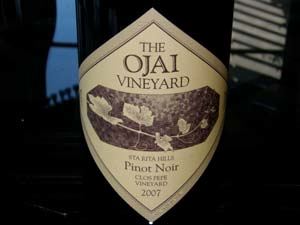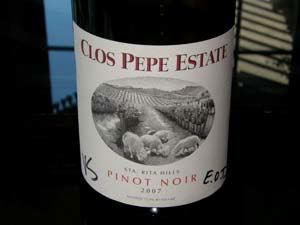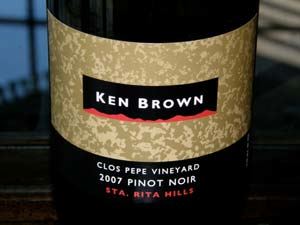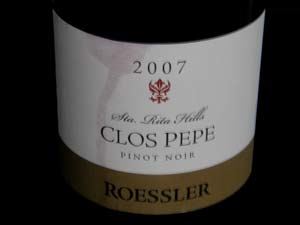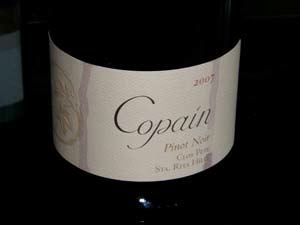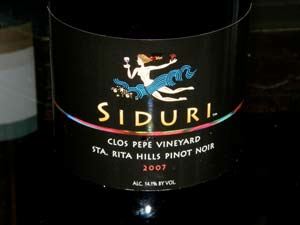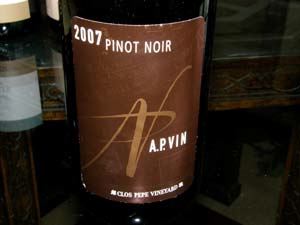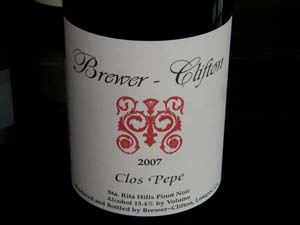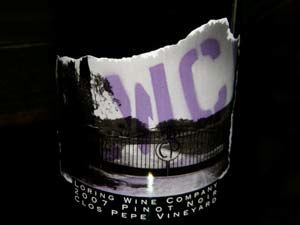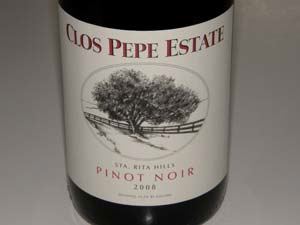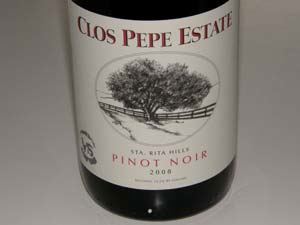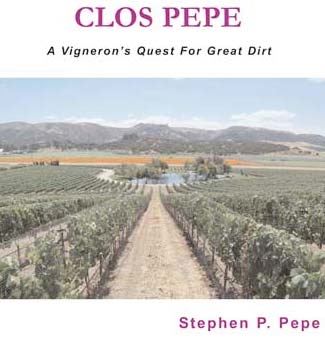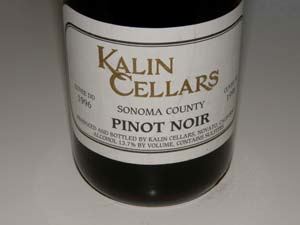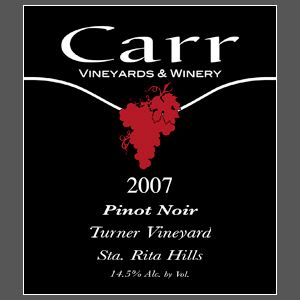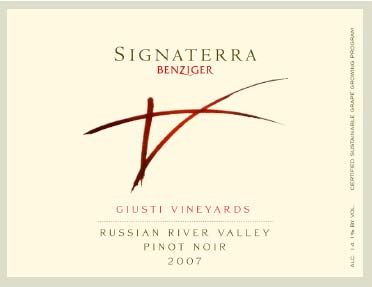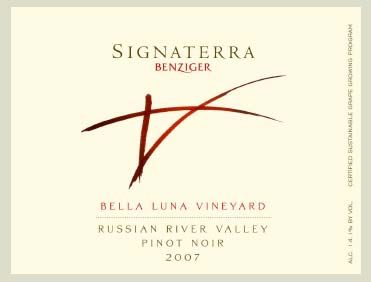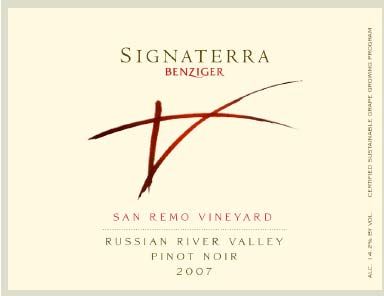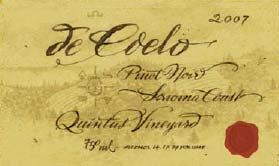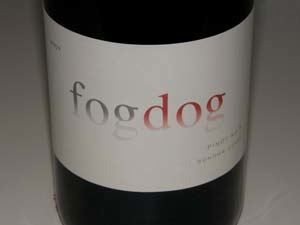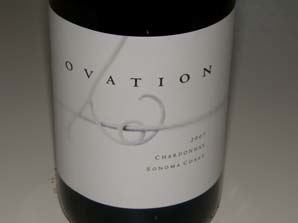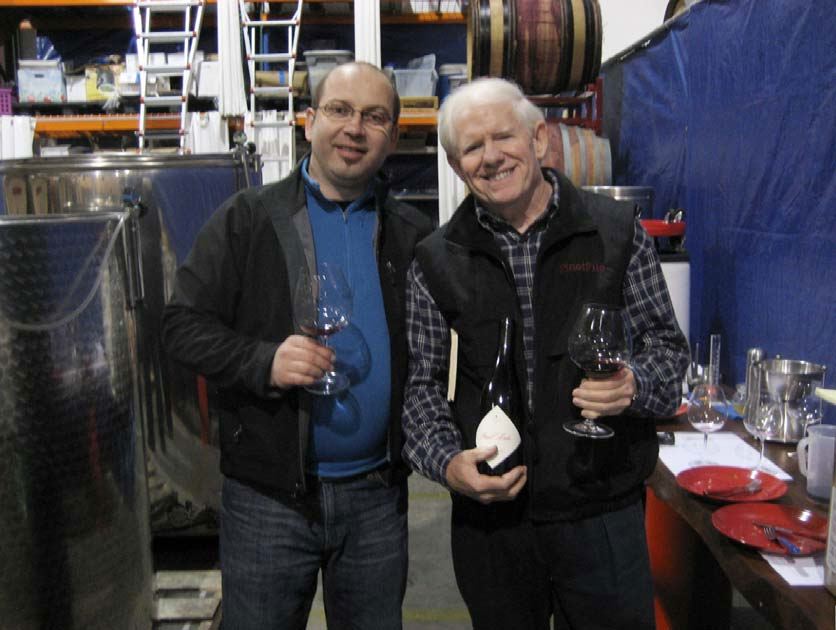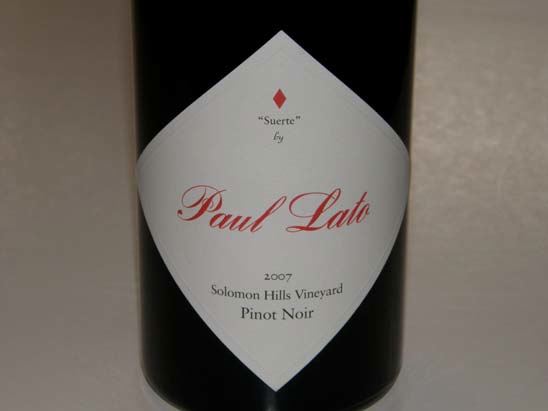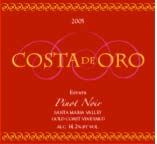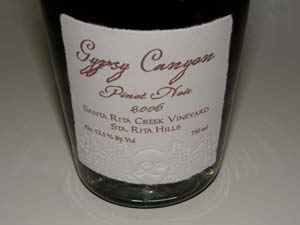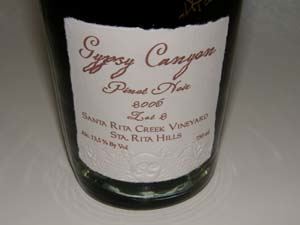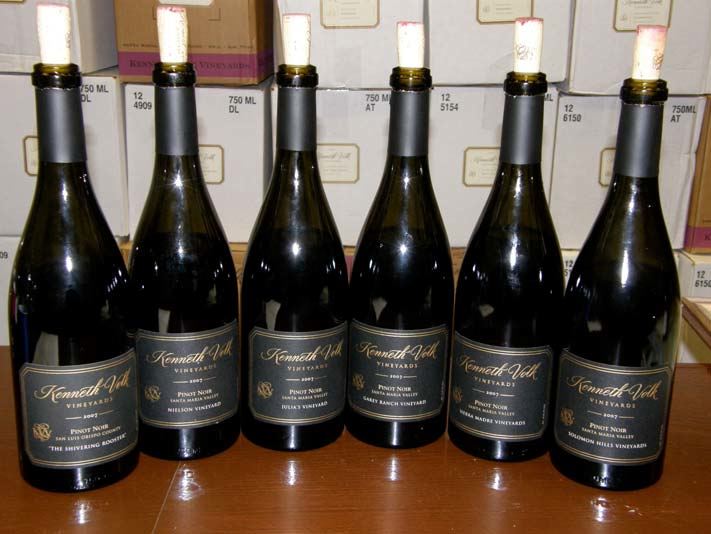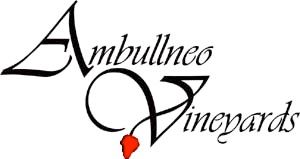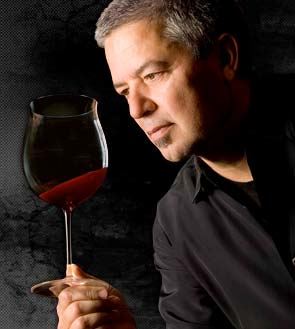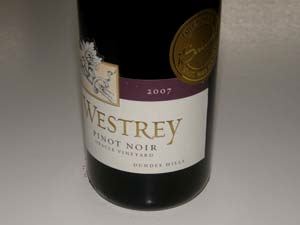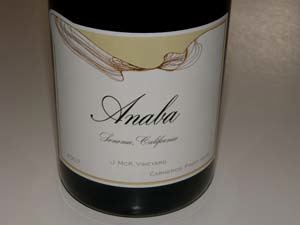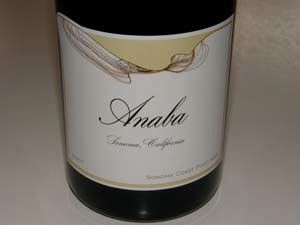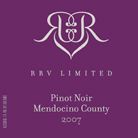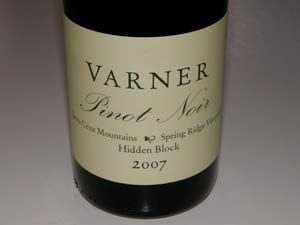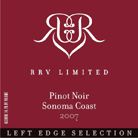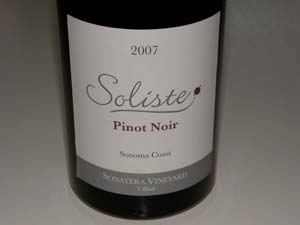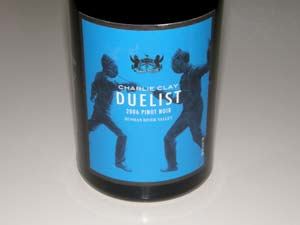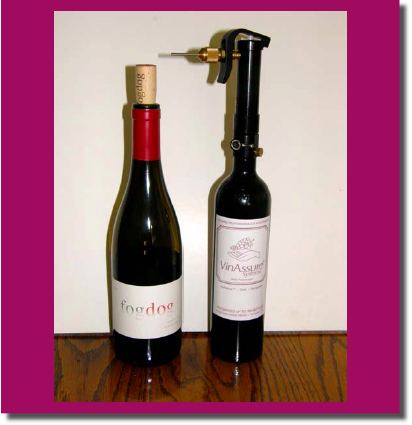PinotFile: 8.12 March 11, 2010
- Clos Pepe: A Grape named Pinot, a Vigneron, a Facilitator, a Dead Head, a Dog named Bud, and a Horse named Charlemagne
- Whole Cluster Fermentation: A Wild Card
- Kalin Cellars: Courting Umami
- Carr Vineyards & Winery: Urban Winery with a Wine Country Soul
- Benziger Pinot Noir Program Now Shines
- On the Pinot Trail: Recent Winery Visits
- Newsworthy Headlines & Trends About Pinot Noir in 2009
- Small Sips of Pinot
- VinAssure™ Wine Preservation System
|
Clos Pepe: A Grape named Pinot, a Vigneron, a Facilitator, a Dead Head, a Dog named Bud, and a Horse named Charlemagne
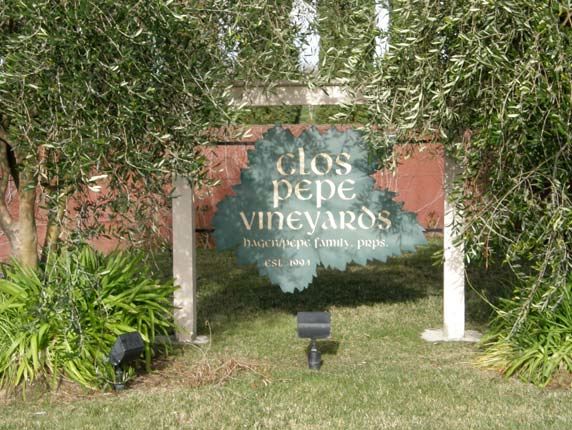
The Clos Pepe story begins with a familiar ring. Stephen P. Pepe grew up in northern New Jersey in a second generation
Italian American family whose love of vino was ingrained in their heritage. His grandfather had emigrated from a village destroyed by the eruption of Mt. Vesuvius and was a respectable home winemaker. Stephen developed an interest in the grape as well, dreaming of one day owning his own vineyard. Years of
education intervened as well as a successful career as a partner in an international law firm. Eventually his
new found discretionary income allowed him to collect and drink wines of the Cabernet Sauvignon persuasion,
but he was to soon develop a higher passion for the “infant terrible” of the wine kingdom, Pinot Noir. In 1990,
Stephen married Catherine Hagen, another partner in the law firm at which Stephen worked, a seminal event that was to take the Clos Pepe story on an adventurous path to the fulfillment of Stephen’s dream.
Catherine and Stephen moved into a small and unimposing house in Long Beach, California, an improbable
site for the birth of Clos Pepe. Stephen’s marriage had inspired him to pursue his lifelong dream to be a
vigneron. He said, “For many people, and I must be one of them, love and marriage provide just the inspiration
and impetus one needs to fulfill what was once merely an elusive fantasy.” The plans for a vineyard in the
backyard were hatched with Catherine’s unwitting blessing. The vineyard’s name originated from the cinder
block wall surrounding the yard (“clos” means enclosure in French). Undeterred by the fact that there was no
historical record of a viable vineyard in Long Beach, and possessing only the rudiments of viticultural
knowledge, the Pepe’s planted 24 Sauvignon Blanc and 30 Pinot Noir vines in their backyard. The first harvest
in 1991 yielded a grand total of four bunches of grapes. The experience, however, had the Pepes hooked on
winegrowing.
Undaunted, the Pepes brought in noted vineyardist, Jeff Newton, of Coastal Vineyard Care, to consult on Clos
Pepe. This was tantamount to asking the Pope to stop by your house to read you some scripture. Once Jeff
had recovered from his amazement upon visiting Clos Pepe and tendered some advice, he told the Pepes that
the Lompoc area of the Santa Ynez Valley on Highway 246 or Santa Rosa Road would be an ideal region for growing Pinot Noir. Stephen had visions of a commercial vineyard which would keep him challenged and
interested, yet providing him a place to eventually retire and find time to travel. He knew he wanted to grow
Pinot Noir and Chardonnay, and the western Santa Ynez Valley seemed to be a perfect fit.
When Stephen and Catherine began a search in earnest for property in the early 1990s, there were just three
wineries and five growers in the Lompoc area. The region, known as the Santa Rita Hills, was not to become
an approved American Viticultural Area until 2001. Several properties became available in the viticultural area
but for various reasons either seemed unsuitable or the Pepes were outbid by others. These properties
became Zotovich Family Vineyard, Rozak Vineyard, Ampelos Cellars and Melville Winery. Serendipity would
eventually shine on the Pepes, who acquired a 40-acre horse ranch in Lompoc located just west of Babcock
Winery on Highway 246. Escrow closed on December 7, 1994, one day before the Pepes’ fourth wedding
anniversary. The property was enclosed, albeit by a horse fence, so the name Clos Pepe could still be
invoked. The property’s wide-body trailer was suitable for temporary living and a large horse barn had the
potential to be be converted into a permanent home. A dream that began as a tiny backyard vineyard in Long
Beach, would become Clos Pepe Vineyards and Estate Wines.
The superficial soils at Clos Pepe were ideal for Pinot Noir and Chardonnay, composed of well-draining
calcareous shale with some sandy loam (the region had been under the ocean at one time). Unbeknown to
the Pepes, there was a hard pan located several feet from the surface which would deter vine roots from
penetrating deeply, discovered after an attempt to grow pumpkins on the property failed. This potential obstacle
was circumvented by deep ripping of the soil before planting. For a full discussion of the soils and microclimate
of Clos Pepe Vineyard, consult the Clos Pepe website at www.clospepe.com. Under the direction of Jeff
Newton, fourteen acres of Chardonnay went into the ground in 1994 using four clones: Davis 4 and 5, Dijon 76,
and Wente. Two years later, fourteen acres of Pinot Noir were planted to four clones: Dijon 115, 667 and 777
and Pommard using an 8’ x 4’ spacing. Because of poor ripening, in 2001, 10 acres of Chardonnay planted to
Davis clones 4 and 5 were budded over to Dijon clones 115 and 777 of Pinot Noir leaving 4 acres of
Chardonnay and 24 acres of Pinot Noir. 650 Tuscan olive trees were added to embellish the landscape and
provide the source for olive oil which would become the source for an award-winning commercial product along
side Clos Pepe Estate wines.
The Santa Rita Hlls is a western sub-appellation of the much larger Santa Ynez
Valley viticultural appellation located between the towns of Buellton and Lompoc in
Santa Barbara County. The eastern edge of Sta. Rita Hills is about four miles west
of Highway 101 in Buellton, and continues to the western boundary, about two miles
east of Highway 1 in Lompoc. The southern boundary is the North side of the Santa
Rosa Hills, with the northern boundary the South side of the Purisima Hills.
Officially, the Santa Rita Hills appellation is Sta. Rita Hills, since Vina Santa Rita, a
123-year-old winery in Santiago, Chile, threatened to file suit in 2001 to stop
California vintners from using the Santa Rita Hills name. The name, Sta. Rita Hills,
was officially adopted in 2006, and is pronounced the same, but reads a little
awkwardly. The Sta. Rita Hills appellation is the only region along the Pacific
coastline where the mountains run true east-west instead of north-south. The two
east-west oriented valleys centered by Santa Rosa Road and Highway 246 create a
gap that allows cooling Pacific Ocean winds to flow inland. When it is hot in Santa
Ynez which is forty miles to the East, it is 20 degrees cooler in the western Sta. Rita
Hills. Fog hovers over the vines until mid morning, and the temperature barely rises
above 75 degrees in the western reaches of the appellation. Mid day cooling winds
off the Pacific Ocean are common, often gusting at 20 to 30 miles-per-hour.
The Sta. Rita Hills appellation spans 30,720 acres (100 square miles), making it one
of the smallest viticultural appellations in California. Over 2,000 acres are planted
to grapes, mostly Pinot Noir with smaller amounts of Chardonnay, Pinot Gris, Pinot
Blanc, Gewurztraminer, Riesling and Syrah.
A map of the Sta. Rita Hills appellation with locations of important vineyards and
wineries is on the Sta. Rita Hills Winegrowers Alliance website at
www.staritahills.com. The map below, taken from the Clos Pepe website,
www.clospepe.com, shows the outline of the larger Santa Ynez Valley viticultural
appellation and the enclosed smaller Sta. Rita Hills viticultural appellation.
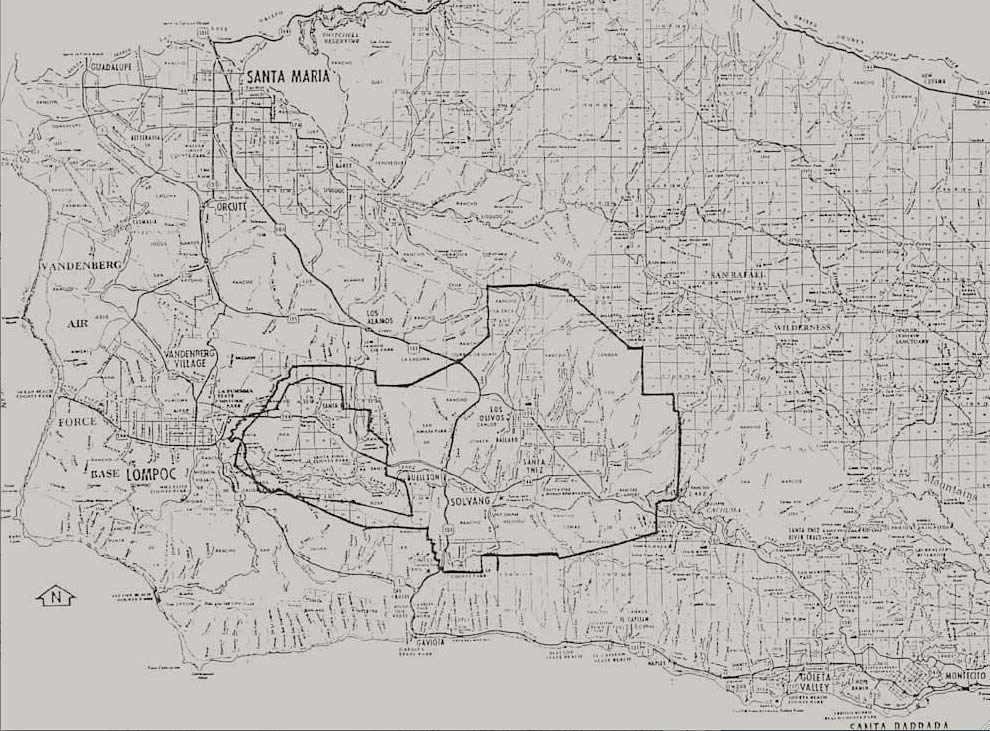
In 1994, Catherine’s second son, Wesley (pictured below), had moved onto the property as a caretaker while
the Pepes continued to make the many weekend trips from Long Beach to Lompoc. His official title was
“Scholar-in-Residence,” as he was a graduate of the University of Redlands with a degree in English and had
set about writing the Great American Novel. His musical interests veered to the Grateful Dead and his drink of
choice was beer (Stephen notes, “He didn’t know the difference between Grand Cru Burgundy and root beer”).
In 1996, wine had begun to pique Wes’s interest and he offered to assist Stephen with his home winemaking
career which dated back to the 1991 vintage. Stephen had acquired grapes each harvest from various Santa
Ynez Valley sources and produced both forgettable and unforgettable Cabernet Sauvignon-based wines
through these formative winemaking years.
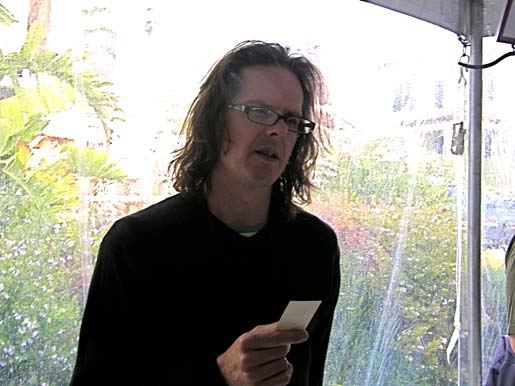
Wes worked the 1996 crush at neighboring Babcock Winery and this experience convinced him that he wanted
to pursue a career as a winegrower and winemaker. As fate would have it, Jeff Newton was heavily involved in
distant vineyard projects and no longer could manage the Clos Pepe Vineyard, departing in 1996. The Scholarin-
Residence put aside the Great American Novel, and stepped in to become the vineyard manager and
winemaker for Clos Pepe.
Wes’s aspirations were fueled by the success of a 1997 vintage Cabernet Sauvignon sourced from Knight’s
Valley and Edna Valley which won a Best of Show Award at the Orange County Fair Wine Competition, and the
Clos Pepe Chardonnay he made in 1998 from the vineyard’s fourth vintage. Wes experienced a revelation in
1998 when he accompanied Stephen to a tasting of the 1995 vintage wines of Domaine de la Romanee-Conti
put on by the Chevaliers du Tastevin in Los Angeles. Stephen was to reminisce, “Wes spent most of the
evening furiously scribbling pages of notes and, when there was a pause in the conversation, peppered Mr. de
Villaine with questions. Wes gushed about the wines for several days.”
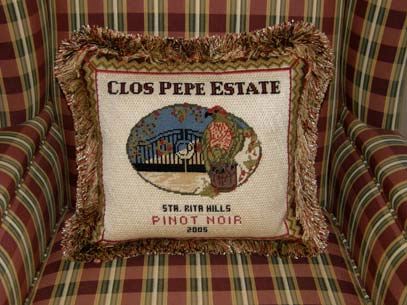
By 2003, Stephen and Catherine had tired of commuting to Clos Pepe
north in Lompoc from Clos Pepe south in Long Beach each weekend
and made a permanent move to their Sta. Rita Hills estate. Catherine
set about directing the conversion of the property’s horse barn to a
Tuscan-styled villa while maintaining her position with the law firm until
2005 to provide the capital for the undertaking. Her needlepoint
pillows and wall decor became a central theme of the interior decor.
“Theme park” embellishments were added to the property over time,
including the first bocce court in the Santa Rita Hills, a basketball
court, a horseshoe pit, a skateboard ramp, and a roller skating rink.
Stephen set off to learn more about viticulture, attending courses at
University of California Davis with Wes. Stephen would be the first to
admit that he was “winging it” when it came to many viticultural decisions at Clos Pepe, but he gained
invaluable experience which was to lead to ultimate success.
Over time a menagerie of animals found a home at Clos Pepe, including six dogs: Bud and Samson, both
Dalmatians, Winston, a pug, Rosa, a border-collie, and Indy and Tiva, both greyhounds. It was Bud that was
most special since he had been with the Pepes since their days in Long Beach. Bud was obsessed with
catching the ducks that lived on the pond of the property but in eight years of trying he was never successful.
Stephen described the dog’s frustration, “The ducks had a clever strategy in which the male ducks would circle
around the females, then one male would peel off as a lure to Bud, who would go after him. Unfortunately,
Bud’s doggy paddle was no match for the mallard’s ducky paddle. If Bud got too close, the decoy duck would
simply take wing and fly about 10 feet to safety. Bud voiced his protest at this ‘fowl play’ by barking furiously at
the injustice of it all.”
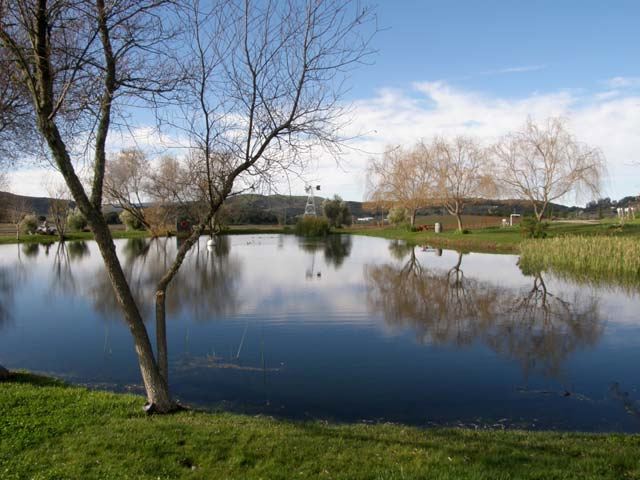
The 2000 vintage brought two significant developments. The inaugural commercial release from Clos Pepe
Estate was warmly received by wine critics, and Wes got married. Wes met his wife, Chanda, at concert where
a Grateful Dead-wannabe band called Family Dog was playing. She had a bottle of wine in hand, and the two
hit it off immediately. Before long she and her horse, Charlemagne, had taken up residence at Clos Pepe and
the couple were married in the midst of Clos Pepe Vineyard on a sunny and blissful September day.
The Pepes found an eager market for their grapes and the demand was a source of pride for the Pepes.
Clients for Chardonnay included Babcock Winery, Hartley-Ostini Hitching Post Winery (vineyard designated
and sold at the Hitching Post Restaurant), Brewer-Clifton Winery (now bottling Clos Pepe Chardonnay under
the Diatom label), Longoria, Ojai Vineyard, and Roessler Cellars. As the Pinot Noir vines came into production,
demand for Clos Pepe grapes was also exceedingly high. Wineries sourcing Pinot Noir over the years have
included A.P. Vin, Arcadian, Bonaccorsi Wine Company, Brewer-Clifton Winery, Carr Vineyards, Copain, Ken
Brown, Kenneth Crawford, Hartley-Ostini Hitching Post Winery, Loring Wine Company, The Ojai Vineyard,
Roessler Cellars, Siduri and Tyler. Today, Clos Pepe sells 75% of the grapes, retaining 25% of their output for
their own estate wine program.
In early February of 2010 I joined Stephen Pepe, Wes Hagen, and Eric Anderson (Grape-Nutz and Grape
Radio) at Stephen’s home for a horizontal tasting of all the 2007 Pinot Noirs produced from Clos Pepe
Vineyard in 2007. The tasting was quite informative because the ten wines were tasted in chronological order
according to when the grapes had been picked during harvest, from the earliest pick (Ojai) to the latest pick
(Loring). The wines were noteworthy for showing the marriage of high natural acidity and moderately high
natural alcohol, typical of Pinot Noir from the Sta. Rita Hills. The early picked wines showed crisp and juicy
cherry and raspberry fruits with prominent minerality and were more terroir driven. The later picked wines
displayed more blue and black fruits, sweet and sappy flavors, notes of tar and creosote, were less nuanced,
and were more barrel and style driven.
Winemaking at Clos Pepe Estate is non-interventional and dictated by the work that goes into growing grapes
that allows picking at optimal ripeness. A cold soak of 2-3 days is followed by fermentation in small open-top
fermenters initially with native yeasts followed by inoculation with RC-212 yeast. The wine is raised in 25% to
50% new French oak barrels, aged for 11 to 19 months, and minimally fined with little or no filtration.
Production of Clos Pepe Estate wines is as follows: 800 cases of Pinot Noir, 75 cases of Vigneron Select Pinot
Noir, and 150 cases of Chardonnay. In drought years production is reduced by 50 to 100 cases and in wet
years like 2005 production is higher by the same amount. In 2008, two-thirds of the vineyard crop was lost due
to frost resulting in a yield of two-thirds tons per acre. Because there were a dozen or so extra uncommitted
barrels, a second label called Axis Mundi was started using Syrah from Sleepy Hollow Vineyard in the Santa
Lucia Highlands. This is a food-friendly wine that avoids the trap of high oak, high tannin, high alcohol and
over ripeness found in many California Syrahs. 300 cases were produced. The Syrah was so well received, the
wine was also produced in 2009. In 2010 a white wine from Chenin Blanc grapes is being contemplated.
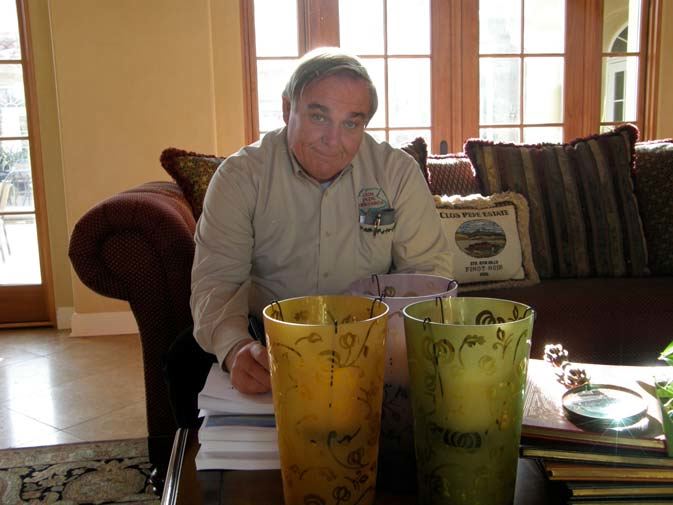

2007 The Ojai Vineyard Clos Pepe Vineyard Sta. Rita Hills Pinot Noir
14.0% alc., $37.40. 100% Pommard clone. Beginning with the 2009
vintage, Ojai will be replaced by Arcadian.
·
A delicate style which is
immensely pleasing. Flavorful red strawberries and raspberries framed
by bright acidity and gossamer tannins. Minerality is prevalent throughout.

2007 Clos Pepe Estate Clos Pepe Vineyard Sta. Rita Hills Pinot Noir
13.9% alc., 550 cases, $54. 50% 115, 25% 667, 25% 777. Beginning in
2008, Pommard clone will be added to the Clos Pepe Estate Pinot Noir
bottling.
·
Lovely aromas of fresh-picked berries, plums, grape must, and a
hint of mint and floral bouquet. Discreetly concentrated core of mildly
sweet red and black fruits, with flavors of sassafras, tea, soy and oak
adding interest. A vein of minerality adds to the pleasure. Smoothly textured with
some persistence on the finish.

2007 Ken Brown Clos Pepe Vineyard Sta. Rita Hills Pinot Noir
14.7%
alc., $50. 100% Pommard.
·
Lightest in color of the lineup of wines.
Demure aromas of cherries and berries. Well-flavored red and blue fruits
with lively acidity on the bright finish. Less tannic and more elegant than
past Clos Pepe bottlings from Ken Brown and more to my liking.
2007 Clos Pepe Estate Clos Pepe Vineyard Vigneron Selection Sta. Rita Hills Pinot Noir
13.9% alc., 72 cases, $59. A tank bottle (from bottom of tank).
Favorite barrels in the cellar.
·
Off scent and flavor which largely resolves over
time revealing shy aromas of black cherries, raspberries and blackberries which
carry over in the flavor profile. Soft and smooth in the mouth, with the fruit well
caressed by balancing tannins and acidity. Not up to the bottle I sampled in May
2009 which was exceptional. Good.
2007 A.P. Vin Clos Pepe Vineyard Sta. Rita Hills Pinot Noir
14.7% alc., $40.
100% clone 115.
·
The nose lacks interest offering primarily aromas of herbal oak
and little fruit. Rich, even sappy, blue and black fruits with aggressive rough
tannins. A simple, husky wine that may be going through a dumb phase.
Decent.
2007 Brewer-Clifton Clos Pepe Vineyard Sta. Rita Hills Pinot Noir
15.4%
alc., $65. The only wine in the lineup with significant (100% in this case) stem
inclusion. Because the fruit is picked late, the stems raise the acidity to balance
the prodigious fruit and tannins. 100% Pommard.
·
Quite distinctive with a
heavily perfumed nose of cut flowers and spice. Plenty of mouth coating sweet
red and black fruit augmented by prominent spice flavors. The tannins are
restrained and well-integrated. An enjoyable sipping wine. Very good.
The 2008 vintages of Clos Pepe Estate Pinot Noir were recently tasted at home in my usual fashion.
2008 Clos Pepe Estate Clos Pepe Vineyard Sta. Rita Hills Pinot Noir
14.2%
alc., 235 cases, $54. Multiple frost events led to a tiny crop of less than a half ton
per acre in some places.
·
Subdued aromas of dark berries with a hint of smoke.
Bright and juicy mineral-laden flavors of red and blue berries. Vibrant and
refreshing with a smooth mouth feel and some persistence. A promising wine
that is still undeveloped and will require time for full oak integration. More
delicate than the 2007 version, but will certainly rival it with more time in the
bottle. Very good.
2008 Clos Pepe Estate Clos Pepe Vineyard Vigneron Selection Sta. Rita Hills Pinot Noir
14.2% alc., $59. Three favorite barrels aged in 66% new
French oak.
·
Noticeably lighter in color than the 2007 version of this wine. Don’t
be put off by the color, however, as the wine is well-structured and full-flavored.
Oak char is dominating the nose at this stage and underlies the flavor profile as
well. Delicious strawberry and cherry flavors peek out which are vivid and
satisfying. The tannins are restrained leading to a pleasingly soft mouth feel.
Immature and closed, this wine will need at least two years in the cellar. Slightly
better the next day from a previously opened and re-corked bottle. Very good.
Stephen Pepe has penned a book that is a compilation of the humorous newsletters that he
sent to friends during the years of 1991 to 1997. He had initially intended to keep friends
apprised of his and Catherine's winegrowing escapades that began with a very modest back
yard vineyard in Long Beach, California in 1991. Starting from scratch with literally no
viticultural experience, the couple eventually established Clos Pepe Vineyards and Estate
Wines in the Santa Rita Hills region of Santa Barbara County.
As a lawyer who had written considerable volumes of legal briefs, Stephen felt that the portrayal
of his story needed to be more succinct and appealing to the casual reader. He enlisted the
services of Susan Duff, a New York writer from whom he borrowed the editorial expertise to
complete the book. As he notes, “While the story is mine, its readability is Susan's.”
Stephen bares all in this slyly amusing story, exposing the many mistakes and miscalculations
along the way that endears the reader to his remarkable, and in a number of instances, dumb
luck success. Like the sharecroppers in John Steinbeck's The Grapes of Wrath, but blessed
with much less impoverishment, the Pepes set out in search of land, risking the reality that the
prospects ahead might not be what they had hoped for. Remarkably, fifteen years after
acquiring a 40-acre horse ranch, Clos Pepe has become one of California's most highly
regarded vineyards and a sought-after source of premium Chardonnay and Pinot Noir.
Cozy up with a glass of Clos Pepe Pinot Noir and enjoy this fascinating story that will keep you
smiling to the end. A great read for wine novices and wine connoisseurs alike.
Clos Pepe Estate wines are available through a mailing list and the winery’s online store at www.clospepe.com.
Of interest is that the label art is changed for each vintage. The artists are asked to spend a day or two at the
vineyard to soak up some “Clos Pepe-ness,” and then create a piece of art that represents the vineyard to
them. A Rosé is also produced and is superb. The 2009 Clos Pepe Estate Extra-Virgin Olive Oil is a Tuscan styled
blend of several varieties of olive trees and priced at $25 for a 250 ml bottle. Stephen Pepe’s book is
available for $25 through the website. I would urge you to schedule a tour of this beautiful property where you
will be warmly received, and taste with Stephen or Wes (805-735-2196). Wes can talk for hours about the
geology of the Santa Rita Hills so you may have to reign him in, and don’t let his English-degree-driven wine descriptive
vocabulary intimidate you. “Wes Hagen Discusses Sta. Rita Hills Geology & Clos Pepe Vineyard"  “Conversation with Stephen Pepe of Clos Pepe Vineyard & Estate Wines” “Conversation with Stephen Pepe of Clos Pepe Vineyard & Estate Wines” 
Whole Cluster Fermentation: A Wild Card
In winemaking there are no absolute truths, no universal approach, no proven methodology. This is what
makes wine so interesting, so variable in its expression, so endearing to the consumer. One man’s whole
cluster triumph is another man's green garden atrocity. The use of whole clusters in fermentation is, as winemaker
Michael Browne of Kosta Browne states, “A bit of a wild card depending on site and vintage. When it works it
affects aromatics and flavors, sometimes in an earthy sense, sometimes in a vegetative sense, and sometimes
in both ways. Some of the aromas and flavors I see are clean earth, green tobacco, unlit cigar tobacco, black
or white pepper and snap peas. Sometimes even cologne or agave. I tend not to like the snap pea or green
profiles.”
Michael Browne’s concerns are widely held, for the unpredictability of whole cluster fermentation can result in a
wine that is herbaceous, vegetate or green. On the other hand, if the stems are mature and the clusters are
never crushed, pumped or damaged in any way to avoid the release of juice from the stems into the wine, the
resulting wine can be enhanced by whole cluster inclusion.
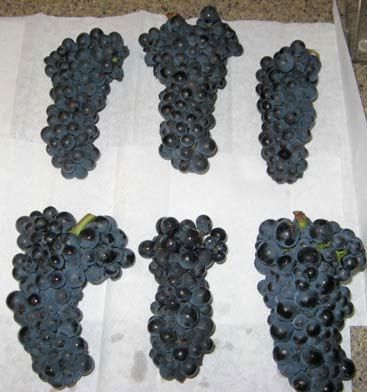
Whole cluster fermentation refers to the fermentation of intact clusters of
grapes (Dijon clusters are pictured) as they are picked from the vine with
no intervention of machines leaving all berries and stems (the part of the
stem which holds the grapes is called the rachis) intact. Traditionally, red
winemaking begins with crushing of the grapes to start to release the
contents of the berries and de-stemming to remove the grapes from the
rachis. A mechanical crusher/de-stemmer is often used. The stems are
often removed in red winemaking before fermentation since the stems
have a high tannin content and when unripe, stems can give the wine a
green aroma due to extraction of 2-methoxy-3-isopropylpyrazine which
has an aroma reminiscent of green bell peppers. With Pinot Noir, even if
the clusters are de-stemmed, the grapes are usually left uncrushed
(“whole berry”) to encourage the development of desirable aromas
through partial carbonic maceration (fermentation within the grape
coincident with fermentation of the juice which seeps out of the grape).
A recent tasting I did in the cellars of Freestone Vineyards with winemaker
Theresa Heredia started me thinking about whole cluster inclusion and how it can affect the aromas, flavors
and tannin structure of a finished wine. We tasted together three samples of 2008 Pinot Noir from barrel that
had no stem inclusion (100% de-stemmed), 30-40% stem inclusion and 100% stem inclusion. I could clearly
taste a step up in aromatic and flavor complexity with increasing amounts of stem inclusion along with a more
bold and lengthy tannin structure. When ripe stems are properly managed, it was clear to me that their
inclusion produced a superior Pinot Noir.
The Burgundians have practiced stem inclusion for centuries, as historically they had no de-stemmers. Today,
many notable Domaines are advocates of whole cluster such as Dujac and Domaine de la Romanee-Conti.
The New World has largely moved away from whole cluster fermentation or limit it to 10% to 30% of the
clusters. There are, however, some devotees who use as much as 100% whole cluster in selected wines
(Ambullneo, Freestone Vineyards, Native9, Tantara, and Windy Oaks among others) with favorable results.
I polled a number of prominent Pinot Noir winery owners, winemakers and a Professor at University of
California Davis to ask them about their understanding of the contribution of whole cluster fermentation to Pinot
Noir. None could elucidate the exact biochemistry involved as this has apparently not been clarified, but their
responses shed considerable light on the role of whole cluster fermentation in Pinot Noir winemaking today. I
have excerpted their comments for brevity.
Pro Whole Cluster
Kevin Harvey, Owner, Rhys Vineyards “I have not studied whole cluster fermentation from a chemical
standpoint. My evaluation of stems has been almost entirely organoleptic. I love the complex spicy, rose petal
aromatics and soft silky texture. I do know that the whole berry fermentation and resulting intracellular
fermentation produce the rose petal aromatic. In addition, the stems add some forest floor elements from the
rachis which become integrated spice with time in the bottle. The tannins also differ in that stems contribute
some tannins (which is often silky smooth midpalate tannin) while preventing the harsh seed tannin from being
released since the grape remains encapsulated longer.”
Jeff Brinkman, Winemaker, Rhys Vineyards “ While I have never seen a biochemical analysis of whole
cluster ferments, I think you could infer the presence of several groups of organic compounds. I would look
into the terpenes, terpenoids and isoprenoids. As you know, the terpenes are responsible for the abundance of
floral aromas in wine. My personal feeling is that since commercially terpenes are extracted from tree resins,
especially conifers, the residual sap in stems may contribute some of the floral aromas and the distinct pine
sap aroma that can be found in whole cluster ferments. Some of the floral aromas are not very different
chemically from those that give pine sap their aroma. Another class of organic compounds, the acetate esters,
may be involved as they form many of the aromatic compounds in wine. I don’t know any of this for fact, its
just what I think about when I am laying awake at 3:00 A.M..”
Theresa Heredia, Winemaker, Freestone Vineyards “Like the grape skin, stems contain phenolic
components, including tannins. Not removing the stems can help improve the phenolic structure of Pinot Noir
since it is a thin skin grape and has little tannin naturally. The stems also contain pyrazines so if the stems are
not ripe enough, they can cause herbaceous characteristics in the wine. However, the combination of the
pyrazines and tannins, along with the many other natural components that stems contain, can add plenty of
lovely spice characteristics to the wine. The riper the stems, the spicier the flavors. The greener the stems,
the more herbaceous the wine can become. We pick with lots of natural acidity and lowish Brix so that the wine is 13.0% to 13.5% alcohol, pH 3.5 or lower. We always notice a better phenolic structure and complexity of aromatic profile in wines such as these, when we use at least a percentage of whole clusters. We only use whole clusters if the stems are beginning to lignify and only if they are relatively thin. In 2009, I opted to only do two 100% whole cluster fermentations because the stems were too thick, juicy and were not very lignified. I did use some percentage of whole clusters, though, with tremendous results. It is a challenge, but it can be done and the result is lovely."
Jim Schultze, Winemaker, Windy Oaks Winery and Vineyards “I have always liked an element of whole
clusters in our fermentations, but our 100% Whole Cluster Pinot Noir release has been a real eye opener. Of
all of our nine 2007 Pinot Noir releases, the 100% Whole Cluster clearly would have the most tannin, yet it is
the smoothest and most approachable at a young age. I don’t think this is a coincidence!”
“Grape stems contain large amounts of phenolics, particular tannins and flavonols, and other flavor
compounds. The key, though is physiological ripeness since immature stems can provide a significant hit of
green flavors. While seeds also contain high amounts of tannin, it is hard to extract. Moreover, stems contain
many other flavor compounds not found in seeds.”
“It is the unusual vineyard that can reliably produce physiologically ripe stems each year. When our fruit is
starting to ripen, I taste the stems on a regular basis. I find that they hit a point where the tannic harshness
disappears and is replaced by a very pleasant smooth flavor. Stems can then contribute these flavors to the
wine.”
“Another dimension to whole cluster fermentation is prolongation of fermentation. I find consistently that our
100% whole cluster fermentations last much longer than our other fermentations. This past fall, our 100%
whole cluster fermentations averaged more than 35 days, while our other fermentations (which were partial
whole cluster) lasted around 30 days. I think the reason is that at the beginning of whole cluster ferments,
some of the fermentation is taking place inside the grapes (carbonic maceration). Over time, the skins begin to
break down and the juice is released, resulting in a more typical fermentation. I have also found that our
fermentation temperatures are lower with the 100% whole cluster fermentation, no doubt extending the
fermentation, but also resulting in a different flavor profile.”
Michael Browne, Winemaker, Kosta Browne “Whole cluster fermentation affects the tannin structure. It can
be a subtle effect or quite grippy. When used as a blending component it can work very well concerning
texture. I found when a bottle is allowed to age, the texture from whole cluster can add a dense velvety
character, but when you omit whole cluster, this character can be a bit more aggressive. I ferment whole
cluster as 100% whole cluster lots so I can then blend just the right amount into the finished wine. More
popular now is to add whole clusters to the fermentation with de-stemmed fruit. Nothing wrong with this but
this is not how I choose to ferment. I find the site has an impact on how the wine reacts as does the vintage. I
test a few lots early in the vintage to see how the vintage will affect whole cluster ferments and I then adjust the
rest of the program accordingly.”
Jeff Fink, Winemaker, Tantara “I am in the midst of assembling the 2008 Pinots and my palate is now acutely
dialed into the merits and downside of stem inclusion. Starting with fruit selection, certain vineyards are better
and more consistently able to achieve riper stems. That begs the question: What constitutes stem ripeness?
The following things are important: (1) Color of the stem. We look for a darker green. Bright lime green
indicates harsher and more astringent tannins, (2) Aromatics of de-stemmed stalks. We look for sweet rather
than overtly herbaceous aromas, (3) Stiffness. We avoid rubbery stems, (4) Lignification. There should be
preferably an inch of woody material where the stem connects to the vine. This can be more or less but the
whole stem is never entirely lignified, (5) Where the berries connect to the stalk should have a dark color and
the berry should be easily removed leaving little pulp. This is all linked to fruit ripeness but certainly there can
be ripe fruit on under ripe stems. In the Central Coast, our extremely long growing season is certainly a benefit
in helping to achieve stem ripeness.”
“What do stems bring to the vinification? We normally ferment about 10% of our lots with some percentage of
stem inclusion. In our small fermenters that hold up to 1.5 tons or 3 picking bins of grapes we might add a bin
of carefully sorted whole clusters and then cover that with a bin of de-stemmed fruit. This protects against the
formation of volatile acidity that can occur in uncrushed exposed grapes. We will also do some 100% whole
cluster ferments. These need to have a juice covering also and we release juice by the traditional method of
pigeage or by foot. We harvest our grapes cool, then cold soak until they reach the temperature where
fermentation naturally starts and we either inoculate with yeast or allow them to ferment on the native yeast.
We find that whole cluster fermentations seem to ferment cooler, longer, and are markedly different in aroma
and flavor. We think this is due to the significant amount of unbroken berries. The stems are the best vehicle
for ensuring a higher percentage of whole berries. We notice no reduction in pigmentation and, in some cases,
the wine may be darker following whole cluster ferment. The whole cluster wines can have more of a green
and chalky astringency when young. For this reason, we tend to avoid stem inclusion from vineyards that
produce naturally more herbal or tannic wines. In riper fruit, we think stems may avoid the production of higher
alcohol and over ripe flavors but we have never quantified this.”
“I am a big fan of the things that whole cluster fermentation can bring to the finished wine. The aromatics can
be thrilling and literally spine tingling. There can be a purity, depth and freshness to the bouquet that almost
defies description. I suppose the case could be made that these wines are stylized. It could also be argued
that these wines represent more of the site and are more minimalist.”
“We typically find that with new world palates it can be harder to achieve an acceptable balance of fruit, aroma
and structure so we have never commercially released a 100% whole cluster Pinot. However, we do bottle
them and as we evaluate how they age that could change. Also, our most expensive wine, Evelyn, has been
the wine with the highest percentage of stem inclusion. This year our proposed final blend will be about 30%. Recently I finalized the 2008 La Colline blend and the addition of 2 whole cluster barrels in the blend made all the difference. Penetrating, almost haunting aromas and a very evocative wine. Tannins are there but soften with exposure to air. Most Pinot to me is lacking in the aromatics. It is the hardest component to capture. Clearly stems rock!”
“In conclusion, stem inclusion brings depth, texture, fragrance, age ability and that mysterious element of
intrigue that all great Pinot should have and aspire to. In 2009, we vinified our first Garys’ Vineyard with stem
inclusion. At this point the results are stunning both aromatically and on the palate. We plan to continue our
study and evaluation of stem inclusion.”
Ted Lemon, Winemaker, Littorai “The most basic chemical fact is that when you add stems to a wine, you
increase the pH and decrease the TA compared to a completely de-stemmed wine. The implication of this is
obvious. If you add a large percentage of whole clusters, you may, depending on region, vintage and ripeness
at picking, have to acidify the resulting wine unless you are comfortable with very high pHs. That is the
downside from a chemical perspective.”
“There is a difference between just adding stems back (which basically no one does) and doing a percent of
whole cluster, because, the whole cluster brings a dimension of carbonic fermentation to the resulting wine.
Besides the carbonic effect, there is also the sensory effect of the stems themselves. They can lend aromas
which range from vegetal to menthol to wintergreen to cinnamon and spices. Stems can also have a dramatic
affect on flavors. They can lend astringency and bitterness. Perhaps the most interesting aspect of stems is
their effect on the tannic impression of a wine on the palate. Some people claim that stems make a wine more
tannic. I would argue the other way. Due to the increase in pH and the presence of a partial carbonic
maceration, whole cluster wines tend to be softer than de-stemmed wines (depending on the region, vintage
and percentage of whole cluster).”
“In summary, the effects of whole cluster fermentation are wide ranging and dynamic and reflective of the
region, vintage and percentage of whole cluster. Over the years, my philosophy has evolved to the following:
1. If the vintage and region lends itself to some percentage of whole cluster, I like to use whole clusters. I find it
adds an extra dimension to the palate and aromas of a wine.
2. Importantly, I find that adding a percentage of whole cluster adds aromatic freshness to older Pinot Noirs. A
Pinot Noir that is ten years old and has a percentage of whole cluster will be more aromatically complex than
the same wine 100% de-stemmed.
3. Region and vintage are the deciding factors. There are some regions where stems do seem to retain an
aggressive green character and therefore it is difficult to do much whole cluster. By the same token, there are
regions which seem to benefit dramatically from a percentage of whole cluster as the added complexity really
changes the wine. An example is Central Otago, where some of my favorite producers do whole cluster and
where we are doing quite a bit at Burn Cottage Vineyard, my client there. The Central Otago fruit seems to
really benefit from whole cluster.
4. Stem ripeness varies dramatically from vintage to vintage and this is an important consideration. Ripeness
is in the eye of the beholder. I will never forget a tasting with Henri Jayer in his cellar in around 1984 when he
stated emphatically that there are never ripe stems in Burgundy.
5. Over the years I have been personally more committed to making wine with no additives except SO2. For
example, at Littorai we use no cultured yeast, yeast nutrients, cultured MI bacteria, bacteria nutrients, enzymes
and, importantly, no acid additions. Therefore, I am very careful that we do not add so much whole cluster that
it would require us to acidify. The final decision on the percentage of whole cluster becomes reflective not only
of region and vintage, but also of the desire to stay true to the path of “natural” winemaking.”
No Whole Cluster
David Lloyd, Winemaker, Eldridge Estate, Mornington Peninsula, Victoria, Australia “I recently attended a
tasting of winemakers’ experiments. Some of the experiments looked at tannins and whole cluster. The
summary of the discussion was as follows. De-stemming and adding back the stems in layers gives coarse
tannins because of cell damage occurring during the de-stemming process. Whole cluster requires earlier
pressing to make sure sappy tannins are not extracted. One experiment involved foot stomping. One batch
was divided into 3. Batch 1 was whole berry de-stem only with 14 day pressing. Batch 2 had 1 hour of foot
stomping about a week after de-stemming to make a soup and was pressed after 14 days. Batch 3 was similar
to batch 2 except pressing occurred after 21 days. Everyone preferred Batch 1 indicating tannin extraction
encouraged by foot stomping is quite different to what happens without it.”
“The problem with whole bunches is that it varies from season to season. In a year where the stems are ripe,
the wine can gain body and an element of tannin that goes well with secondary fruit flavors ten years down the
track. The green edge is very hard to predict. I have seen yanks and yocals carry on how they have a test or
that they can chew the stems to determine ripeness, but my observations are that years of experience helps
but it is still hard to get right.”
“The off feature is a green, herbal element that goes from an edge to a dominating feature. Some areas can
risk it more often than others but my feeling is that you don’t want to fight terroir. Generally, my Pinot Noir is
about pretty fruit flavors and elegance. Stems will either give me a green edge to that, or too much tannin or a
very herbal feature, so after five years of experiments, I gave up.”
“Many places in Sonoma, for instance are fine, but if they choose to pick less ripe I wonder whether they too
will have greenness as a feature rather than an edge. Burgundians have largely moved to 100% whole berry
and sometimes add back stems or add a percentage of stems at a selected point in the ferment. Someone has
done work on the green feature versus the time stems are added, and I have a vague memory that a green
edge develops if whole bunch is present during cold soak and does not develop if stems are added back when
the ferment is under way.”
Jesse Lange, Winemaker, Lange Estate Winery (Oregon) “Ahh, whole cluster fermentation. We don’t
employ that technique here at Lange Estate for the most part. I do, however, try to have a percentage (75%) of
whole berry going into the fermenters. Most of those berries will be broke in the first few days, to avoid a
heavy percentage of carbonic maceration, but I like the varying rates of “mini-fermentations” within the must.
Most of the whole cluster trials we have done here indicate that, on the whole (pun intended), it doesn’t fit our
style, especially when it comes to texture. Stem ripeness is the largest factor for whole cluster and trying to
locate that moving target can be tricky for sure. The wood tannins can certainly add some structural backbone,
but they can also influence texture and mouth feel in a negative manner. When I worked at Santa Barbara
Winery in 1996 and 1997, I liked whole cluster ferments for some of our lots of Pinot Noir and Syrah, and not
so much for others. The stems in Santa Barbara County seemed to be far more advanced in lignification than
those here in the Willamette Valley.”
Laura Volkman, Laura Volkman Wines (Oregon) "While I don't have experience with whole cluster fermentation, I do have a few comments. My theory is that the stems/rachi need to be mature and brown at harvest to add desirable wood stem tannin and aromas to the wine. In a cool year, the stems could add those undesirable bitter harsh green tannins and make the wine herbaceous. In an optimal year, I have worked with winemakers who add 10% or so whole clusters to the fermenter and the wines ultimately show more tannin, toast and nice astringency than if the stems were not added. These winemakers ran the rest of the grapes through the crusher.
In carbonic maceration whole cluster fermentation, the grapes are not run through the crusher to avoid twisting and scraping of the stems during processing and maintain whole berries. They are added directly to the fermenter and the extraction is done in a carbon dioxide saturated environment. The theory is that whole cluster is more gentle on the fruit overall, more of the berries are left intact along with the stems/rachis, and any extraction from the wood stems is softer allowing more of the fruit to show through.
While I think whole cluster wines are lovely and I enjoy them on occasion, my style is more traditional with gentle punch downs that extract tannins from the skins and seeds. I can control and balance this with fermentation temperatures and more or less aggressive punch downs. I think tannin extraction is very personal to the winemaker's palate, especially post fermentation. We need to get our head and hands in the fermenter during this time to know when to press off.
Wes Hagen, Winemaker, Clos Pepe Estate Vineyard and Estate Wines “Whole cluster fermentation is a
Burgundian affectation that I have experimented with. While I agree that it adds some tannin and mid palate
mouth feel to young wines, the broccoli stem/veggie/soy sauce character it seems to add to a young wine is not
a flavor I enjoy in Pinot Noir. I spend considerable time with canopy management to get the veggie out of Clos
Pepe fruit and not sure why I would want to put the flavor back in via stem inclusion. When asked why I don’t
use stems in Clos Pepe wines, I usually give two answers: #1 I grow grapes to make wine, not stems, and #2 If
you need better mouth feel out of Pinot Noir, structuring the wine with a little more acidity seems to be a better
solution than letting the grapes get too ripe and flabby and then using stems to put a bit of bones back onto the
flesh.”
“Stem inclusion does seem to integrate in a bottle-aged Pinot Noir, say 4 to 5 years down the line, just like oak,
but at that point the tannins are mostly polymerized anyway, and the contribution to mouth feel is likely minimal.
I believe taking Burgundian production techniques and applying them to California Pinot Noir is antithetical to
developing our own regional identity - like bringing Hinduism to Salt Lake City. You may start with a few
adherents, but eventually you will be talking to yourself.”
An Academic Viewpoint
Roger Boulton, Stephen Sinclair Scott Professor of Enology and Chemical Engineering, University of
California at Davis “The contributions of whole cluster fermentation are at least due to two aspects: the intact
berry aspect of the whole cluster, and the extraction and adsorption properties of the stems. The first would be
similar to that of whole berry effects, which make small contributions normally seen in carbonic maceration.
The berry cells undergo a biochemical modification internally, partly fermentation like, but with significant
modification of monomeric phenols that results in the carbonic maceration aroma character. This is generally
released and most obvious at pressing when it is mostly released into the surrounding wine. The second
aspect is thought to be minor, even insignificant from a sensory point of view. While stems can have higher
tannin concentrations than berries, there is little evidence that it is actually extracted under winemaking
conditions. In fermentations with dry, woody stems, there can be a herbaceous aroma contributed, even a
black tea or cedar character. The trials of stem additions that resulted in the tea and cedar character were
when stems which had been removed from the berries were added back and not whole cluster fermentations
as such. Similarly, there might be some components that would be adsorbed to the stem tissue, but I know of
no data that establishes this, either positive or negative.”
“There are some questions whether these practices developed from reliable sensory trials, or rather came
about by people going back to minimal handling at the point of cluster to juice, and how much whole clusters
and intact berries survive the first days of punch downs, treading, or pump overs. I do not know of any well controlled
trials that have shown significant and reproducible effects, despite considerable anecdotal opinion.”
“There are questions regarding Pinot Noir flavor and aromas versus treatment and other contributions due to
style. There will always be the question of expression of terroir and whether stylistic practices mask it or not.”
Kalin Cellars: Courting Umami
Microbiologists Dr. Terry Leighton and his wife Dr. Frances Leighton founded Kalin Cellars in Marin County in
1977. Terry was the original winemaker at Domaine Laurier in the 1970s before launching his own label. Over
the ensuing years, the Leightons have labored in relative obscurity shunning publicity while producing some of
the most interesting California wines that only wine critics and wine geeks loudly testify to. The winery is
located in an undistinguished warehouse in Novato, California, where the eccentric couple craft wines of
unique character, age ability and individuality.
The name Kalin (KAY-len) is a local Indian word for ocean and the Leightons chose this name because it was
the only Indian word they could pronounce. The mantra behind the label is the use of traditional, hands-on,
labor-intensive methods that do little or nothing to disrupt the character of the wine. In other words, “Produce
no wine with less character than yourself.”
Terry was the pioneer of unfiltered, sur lie-aged white wines in California dating back to 1981. The Leightons
have used their background as research scientists to conduct studies on yeasts and chose yeasts that are very
slow fermenters, believing slow fermentation is key for the evolution of flavors in wine, particularly the fifth
taste, umami. Described as savory, pungent and meaty, umami is secondary to glutamates common in aged
cheeses, meats and wines. The Leightons believe that most wines are not capable of acquiring umami
because they are made quickly, sold shortly after each vintage, and consumed long before the fifth flavor is
attained. The Leighton’s therefore release no wine before its time.
Their style of winemaking produces wines that are not even close to being ready for at least five years.
Unheard of in the modern business model of wine sales, they follow no set vintage sequence. The wines are
released to the market when the Leightons feel they taste good, usually between 5 to 10 years after the
vintage! The current releases of Pinot Noir are the 1998 Cuvée DD Sonoma County and the 1994 Cuvée
Billon (Cuvée Rare) Sonoma. A 1997 Potter Valley Sauvignon Blanc Reserve and a 1994 Cuvée LD Sonoma
County Chardonnay , a 1994 Cuvée DD Sonoma Chardonnay, and a 1994 Cuvée W Livermore Valley
Chardonnay are also current offerings. Essentially every wine Kalin Cellars releases is a library wine! Check
previous issues of the PinotFile for reviews of the 1990, 1994 and 1995 vintages of Pinot Noir. My favorite of
all the Kalin wines may be the Semillon which is worth a search.
The Kalin Cellars Pinot Noirs are for connoisseurs and lovers of aged wine. They offer secondary bouquets
and flavors that drinkers accustomed to young wines may find unpalatable. Look for notes of earth, forest floor,
meat, soy and leather set off by racy acidity.
Most Kalin wines are uniquely designated by letters which are shorthand for identifying specific vineyard
locations and signifying cuvées. Prices are quite reasonable ($30-$45) considering the wines have been
cellared for years before release. The quirky website lists currently available wines for sale. Production is
roughly 7,000 cases annually. To order wines, fill out the online order request form. A few select retail outlets
(www.klwines.com, Bristol Farms markets in California) and wine savvy restaurants offer the wines as well.
Terry will be making a rare appearance at the Redwood City K&L Wines store on Friday, March 19th from 5:00
to 6:30 P.M. for those who live in the Bay Area. The winery is not open for tasting or tours. You can contact
Terry (“Dr. Fermento”) by e-mail at tjl@ix.netcom.com. 415-883-3543.
1998 Kalin Cellars Cuvée Sonoma County Pinot Noir
13.8% alc., $45.
·
Deep reddish-brown, even
mahogany color in the glass. Subdued aromas of macerated strawberries, brown spices, leather, roses and
green garden. Performs better as it opens in the glass. On the palate, the berry fruits are complimented by
flavors of brown sugar, bacon, smoke and grapefruit. A lively grip of acidity highlights the finish. Good.
1996 Kalin Cellars Cuvée DD Sonoma County Pinot Noir
13.7% alc., $45.
·
Moderately deep reddish-purple color with a golden rim in the glass. Much better
color than the 1998 vintage. Aromas of beef stew, marzipan, and bacon fat with
a hint of smoke, ash, nuts and latrine. Many subtle and highly nuanced flavors
including blackberries, plums, beef, braised meats and a lingering hi-strung citrus
note on the snappy finish. Still possesses some rich fruit on the mid palate and
the mouth feel has become plush and inviting. Has held up extremely well with
considerable interest and intrigue and will perform nicely at the table. Very good.
Carr Vineyards & Winery: Urban Winery with a Wine Country Soul
There are some wineries that just exude class and when you visit the Carr website or look at their handsomely
appointed wine bottles, you understand the people behind get it. The winery (pictured below) is located in a
1940s Quonset Hut in downtown Santa Barbara, but the wines are rooted in Santa Barbara County wine
country soil.
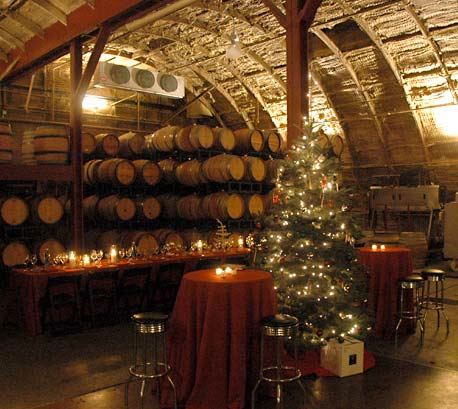
Carr Vineyards is also a vineyard management and development company that currently supervises over 100
acres of vineyards spanning Santa Barbara County. Ryan Carr is the man in charge and he insures that the
grapes for his wines are grown to his exact specifications. He wears many hats as the owner, winemaker and
grower for Carr Vineyards & Winery. The winery’s first vintage was in 1999, consisting of a whopping ten cases
produced in Carr’s home garage. Currently the Carr Winery produces over 2,500 cases of multiple varietals
including Pinot Noir, Pinot Gris, Grenache, Syrah and Cabernet Franc. The winery’s focus is on the Sta. Rita
Hills viticultural appellation.
The Carr urban tasting room at 414 N. Salsipeudes St. in Santa Barbara is open daily from 11:00 to 5:00 with
the Wine Bar open Thursday through Saturday from 5:00 PM to 12:00 AM. The Carr wines are sold through
the web-site's online store at www.carrwinery.com.
2007 Carr Vineyards & Winery Three Vineyards Sta. Rita Hills Pinot Noir
14.5% alc., 303 cases, $40.
Sourced from Turner, Yard and Lindsay’s vineyards, all located in the Sta. Rita Hills AVA. Clones 114, 115, 777
and Pommard. Aged 12 months in 15% new French oak.
·
Aromas of darker cherry and berry fruit with notes of
marzipan. Juicy core of black cherry fruit with underlying forest floor and earthy flavors. Bright acidity and
softly toned tannins with some persistence of pleasing dried cherry on the aromatic finish. Good.

2007 Carr Vineyards & Winery Turner Vineyard Sta. Rita Hills Pinot Noir
14.5% alc., 299 cases, $40. This vineyard was established by Dennis Turner in
2000 and planted and cultivated by Ryan Carr, consisting of 15 acres of Pinot
Noir, 3 acres of Pinot Gris and 3 acres of Syrah. Fourth harvest yielding 2 tons
per acre. Aged for 12 months in 20% new oak.
·
Pleasing aromas of berry jam,
cherries, spice and nutmeg gathering intensity with time in the glass. Delicious essence
of black cherries with hints of red licorice and minerality leading to a tangy and lengthy
finish highlighting bright cherry aromas. The slightly grainy tannins are well integrated
and the lively acidity provides refreshing drinking. A well composed and impressive
effort that really shows off the purity and vividness of Sta. Rita Hills fruit and acidity.
Benziger Pinot Noir Program Now Shines
Benziger Family Winery has achieved a well-deserved reputation for pioneering sustainable, organic and
Biodynamic© winegrowing in Sonoma County. In the past, Pinot Noir was not the winery’s main focus, but if
you visit the website home page now, you will see Pinot Noir prominently touted including a special 3rd Annual
Winemaker Pinot Noir Cellar Dinner on March 6, 2010 in the Benziger Wine Caves. At this dinner, winemakers
Mike Benziger and Rodrigo Soto are to lead the attendees through a collection of limited production, single
vineyard and estate Pinot Noirs.
The Benziger family has been growing grapes on Sonoma Mountain for close to thirty years. In the mid 1990s,
Mike Benziger befriended Alan York, one of the leading international experts on biodynamic farming. The
resulting transition to biodynamic farming resulted in a higher caliber of Benziger wines.
Chilean-born Rodrigo Soto joined Benziger as director of winemaking in 2006 and manages the Signaterra
winemaking program. The Signaterra wines are premium vineyard designated varietals including Pinot Noir,
Sauvignon Blanc, and a Bordeaux blend. Soto’s experience with biodynamic farming dates to his work as
winemaker at Matetic Vineyards in San Antonio, Chile. He works in tandem with Mike Benziger who acts as
General Manager and primary winemaker for the Tribute line of Benziger wines.
The newest vintage of Pinot Noirs are wines you can really get your teeth into and are highly recommended.
All four of the wines reviewed below are charming and beautifully balanced, and picking one out for special
merit is really just a matter of personal preference. Winemaking is traditional for Pinot Noir. After destemming,
the whole berries are fermented in open top fermenters and cold soaked for 5 to 6 days. Native
yeast powers primary and secondary fermentations.
Benziger wines are available online at www.signaterra.com and www.benziger.com. The Sonoma Mountain
tasting room is open daily and special estate vineyard tours and tastings are available by appointment
(707-935-4527).

2007 Signaterra Benziger Bella Luna Vineyard Russian River Valley Pinot Noir
14.1% alc., pH 3.50, 1,350 cases, $49. The Bella Luna
Vineyard is one of the coolest vineyards in the Russian River Valley.
Clones 115, 667 and 777 are planted in Goldridge soils and the vineyard
is now in transition to official Demeter Biodynamic© certification. Aged 11
months in 35% new French oak.
·
Moderately dark reddish-purple color in the
glass. Haunting aromas of darker berries, oak vanillin and toast. Very tasty
panoply of purple fruits with hints of cranberry and pomegranate. Rich and
persuasive on the palate filling the mouth with pleasure and leaving a smooth
and soft imprint on the pleasing finish. A fruit driven style with restrained tannins
and a hint of lemon peel on the lively finish. A lovely wine that will find many fans.
2007 Signaterra Benziger Giusti Vineyard Russian River Valley Pinot Noir
14.1% alc., pH 3.47, 825 cases, $49. From a 7-acre vineyard planted in 2000 to
clones 667, 115 and 777. The vineyard is located in one of the warmer areas of
the Russian River Valley, nicknamed the “banana belt” of the appellation.
Certified sustainably grown. Aged in 35% new French oak for 11 months.
·
A fruity
nose displaying aromas of Bing cherries, strawberries, raspberries, cut flowers
and herbs. Delicious black cherry bombast that is discreetly concentrated and
embellished with notes of dark chocolate, cola, spice and edible flowers. Silky
and delicate, this wine is quite charming with respectable length on the pleasing
finish. Very good.

2007 Signaterra Benziger San Remo Vineyard Russian River Valley Pinot Noir
14.2% alc., pH 3.62, 650 cases, $49. 5.24 acres planted to
Dijon 115, 667 and 777 in Goldridge series soils. Farmed sustainably.
Aged 11 months in 35% new French oak.
·
I just loved the nose of delicately
spiced cherries. Lovely and generously flavored dark red cherry,
strawberry and rhubarb fruit with the faintest underpinning of oak, loamy earth
and spice. Juicy and bright with the fruit-forwardness that has made Russian
River Valley Pinots so desirable.
2007 de Coelo Benziger Quintos Vineyard Sonoma Coast Pinot Noir
14.1% alc., pH 3.48, 475 cases, $69. Sourced from an estate vineyard located
in the Freestone Occidental area five miles from the Pacific Ocean. 25 acres,
Demeter Certified Biodynamic©, at the edge of where Pinot Noir will grow.
Yields 2 tons per acre. Aged 18 months in 50% new French oak.
·
Distinct from
Russian River Valley Pinot Noirs for its more savory, mineral-driven and
earthy core. Aromas of wild dark berries, sweet pipe tobacco, forest floor and
oak char. Intense and dense on the palate featuring the pure essence of dark
red and black berries robed in sweet oak with a hint of citrus in the
background from zippy acidity. Very smooth in the mouth with restrained tannins. Will need time to fully
integrate the oak. This wine will appeal more to lovers of savory tones than fruity intensity . Very good.
On the Pinot Trail: Recent Winery Visits
Freestone Vineyards
I recently reviewed a number of current releases from this newer Sonoma Coast winery (Volume 8, Issue 7,
www.princeofpinot.com/article/810/). Here are some additional bottled wines I recently reviewed and some
impressions from several 2008 barrel samples.
I continue to be very impressed by the consistent quality of the Freestone Vineyards wines. Admirably, the
winery has lowered their prices in response to the economic conditions. The Fogdog wines represent the entry
level, value-priced wines in the portfolio but they are very good wines in their own right. A fogdog is a bright or
clear spot that appears in breaking fog and is often observed in the Freestone area.
The estate Chardonnay clones include 2A (Wente), Mt Eden, 548, Dijon 76 and suitcase selections. Pinot Noir
plantings include Dijon clones 115, 777 and 828, and heritage selections. The Calera selection of Pinot Noir
really shines in the Freestone plantings.
2007 Fogdog Sonoma Coast Chardonnay
13.5% alc., $35. Sourced from
Dutton Ranch Mill Station and Sullivan vineyards. Aged 15 months in 60% new
and 40% two to three-year-old French oak barrels.
·
Demure aromas of lemon
meringue tart and white stone fruits. Bright and crisp on the palate featuring
flavors of peaches, lemon curd and grapefruit with the faintest oak. The fruit
gives a delicate impression of sweetness. Good.
2007 Ovation Sonoma Coast Chardonnay
14.0% alc., $45. A mix of estate
vineyard fruit (61%), Dutton Ranch (21%) and Bacigalupi (18%). Aged 15
months in 60% new and 40% two to three-year-old French oak barrels. The lees
are stirred frequently during primary fermentation (once a week) but not during
secondary fermentation. Meant to be a rich, full-bodied California styled
Chardonnay.
·
Light golden yellow in color in the glass. Delicate but pleasing
scents of lemon curd, pear, white peach, tropical fruits, and steely minerality.
Delicious core of citrus and pear flavors with a hint of caramel and baking spice
all underlain with a crushed rock minerality. A citrus tang lifts the bright finish. A
highly nuanced wine that aims to please. Very good.

2007 Fogdog Sonoma Coast Pinot Noir
13.5% alc., $35. 100%
estate grown. A mixture of several Dijon clones and several heirloom
selections. Aged 15 months in 40% new and 60% two to three-yearold
French oak barrels. Slow fermentation with 20% whole clusters.
·
Dark and dense reddish-purple color in the glass. Lovely aromas of
intensely perfumed wild berries, raspberries, and plums with a hint of
exotic spice box and oak. Remarkably rich for an entry level wine flaunting a
flavor palate of macerated berries, plum and pomegranate. Restrained, slightly
grainy tannins and a zippy, refreshing finish that features citrus peel and dried
berries. A good food wine with the right mix of intensity and delicate balance.
Very good.
2007 Freestone Vineyards Sonoma Coast Pinot Noir
13.5% alc., $55. 100% estate grown fruit. Aged 15
months in 65% new and 35% two and three-year-old French oak barrels. 43% whole cluster.
·
Nuanced
aromatics featuring scents of berry tart, sandalwood, and barnyard. Spicy, tenacious palate of wild berries and
plump cherries set off by notes of savory herbs and sweet oak. Rich and generous, yet offering style and
grace. Just when you are content, it wows you some more with a memorable spice box finish. Very good (+).
2008 Freestone Vineyards Pastorale Vineyard Sonoma Coast Chardonnay
Barrel sample. From a single
500L oak puncheon.
·
Strikingly nuanced with aromas of yellow stone fruits, spice and petrol. Rich and mouth
filling white peaches, tropical fruits and citrus combine with subtle oak highlights to produce a beautifully
composed wine that will be special when bottled.
2008 Freestone Vineyards Quarter Moon Vineyard Sonoma Coast Pinot Noir
13.26% alc.. 100% whole
cluster fermented in an oak open-top fermenter.
·
Hi-tone aromas of well-spiced red fruits. The layered fruits
are vivid and juicy accented by notes of earthiness and savoriness. Despite the whole cluster fermentation, no
sign of a green edge. Still has tannins to shed. The acidity is bright. More forward than the 2007 vintage.
Visit the winery website at www.freestonevineyards.com to acquire. The winery’s guest center in Freestone is
open on weekends. Significant discounts are offered to wine club members.
Paul Lato Wines
I recently stopped by Central Coast Wine Services in Santa Maria to check out Paul’s new digs. He has moved
into a more spacious spot and now has room for a large barbecue for cooking (Paul is a chef as well). I have
never met a winemaker that exudes more passion and enthusiasm for his craft than Paul. In a newsletter sent
at the end of 2009, Paul wrote,”Great wine is supposed to first inspire you, but then it’s supposed to disappear.
Because after the wine is poured, then it’s just about friendship, about communication, about love, wonderful
things that happen between friends. Truly great wine is not shy. It is well balanced and harmonious, and
knows that it is a vital part of the moment. Yet it doesn’t have to scream. It doesn’t have to be constantly
present. Instead, it becomes the intermediary, the facilitator of conversation and feelings that we share as
friends. That’s the message in the bottle.”
I tasted through barrel samples of Paul’s 2008 Pinot Noirs which were in tank scheduled to be bottled in the
following day or two. After Paul speaks so eloquently about each wine and gushes with fatherly pride, it is
difficult not to like the wine. You feel like hugging him, hugging the tank, jumping up and down, and whooping it
up. Paul says the 2008 wines are the best he has made to date (I know, you always hear this from
winemakers, but I will pass it on anyway). He likens the 2008 wines to Julia Roberts: charming but plenty of
structure in the right places.
The 2008 vintage wines will be released at the end of February and include a Chardonnay and four vineyard designated
Pinot Noirs from Fiddlestix, Gold Coast, Pisoni, and Solomon Hills vineyards. 2008 is the first year
for a Paul Lato Pisoni Vineyard Pinot Noir. Paul is sourcing from a small parcel from a 25-year-old block that
Gary Pisoni has always kept for his own Pisoni Estate Pinot Noir.
These wines were also sampled out of barrel in May 2009 after the World of Pinot Noir event in Shell Beach,
California (www.princeofpinot.com/winery/446/).
2008 Paul Lato “Le Souvenir” Sierra Madre Vineyard Santa Maria Valley Chardonnay
150 cases, $50.
Barrel sample. Sourced from the Sierra Madre Vineyard in Santa Maria Valley. 11 year-old Wente clone vines.
70% new oak, 100% MLF, aged sur-lie, native yeast fermented, only first pressing, lightly filtered.
·
Attractive
scent of lemons and roasted nuts. Delicious flavors of citrus and creme brulee with the faintest hint of oak.
Think Aubert Chardonnay brought down a notch. Very good (+).
2008 Paul Lato “Duende” Gold Coast Vineyard Santa Maria Valley Pinot Noir
100 cases, $60. Barrel
sample. Aged in 50% new French oak barrels. Martini clone, 14 year-old vines.
·
Light in intensity and highly
aromatic in the fashion of a Chambolle Musigny. Dark fruits, underlying earthiness and edible flower. Well structured
to last. Down the road will become even more savory. Very good.
2008 Paul Lato “Matinee” California Pinot Noir
75 cases, $35. Barrel sample. This is Paul’s first attempt at
a blended wine using barrels from Solomon Hills, Pisoni and Gold Coast vineyards that didn’t fit the vision for
the single vineyard bottlings. Inexpensively priced as a thank you to customers and possibly a good fit for
restaurant by-the-glass programs.
·
A simple, delicately composed wine featuring dark Pinot fruits with a healthy
tannic backbone and a somewhat shallow finish. A perfect daily drinker. Decent.
2008 Paul Lato “Suerte” Solomon Hills Vineyard Santa Maria Valley Pinot Noir
$65. Barrel sample.
Clones 115, 667 and 777.
·
Appealing scents of spiced dark fruits and wet leaves. Moderately rich essence of
blue and black fruits with a spicy, earthy underpinning. Impressive persistence on the generous finish. The
tannins are well proportioned. Still very young but superb potential. Very good (+).
2008 Paul Lato “Sine Cera” Fiddlestix Vineyard Sta. Rita Hills Pinot Noir
$70. Barrel sample. Clones 115,
667, 777.
·
Moderately dark reddish-purple color. More tannic, loamy and savory than the other wines in the
lineup. The well-hung core of dark fruit is brooding which is not surprising as this wine is typically slow to
evolve. Big but not at all jammy. Develops increasing charm with time in the glass. Very good (+).
2008 Paul Lato “Lancelot” Pisoni Vineyard Santa Lucia Highlands Pinot Noir
75 cases, $75.
·
Paul tried to
invoke his trademark elegance with this wine but it is still BIG. It is stacked and packed with blackberries, black
raspberries, black plums, and cola, with a woodsy, toasty and grilled meat character. It is a formidable wine that
lacks charm and is not open for business at present. Judgment is out on this one until the wine mellows some
through bottle aging. Pisoni unplugged.
Paul Lato wines are sold through a mailing list at www.paullatowines.com. Since production is so limited,
public tastings are not offered except at certain events such as the World of Pinot Noir.
Costa De Oro Winery
Though born into a farming family, Gary Burk’s first love was music. After earning his business degree from
Cal Poly at San Luis Obispo, he moved to Los Angeles to pursue a career as a musician. During his time in
Los Angles, Gary’s father Ron Burk partnered with Bob Espinola and planted the 30-acre Gold Coast Vineyard
located six miles east of Santa Maria on Foxen Canyon Road. This sparked an interest in grape growing in
Gary and he began selling Gold Coast grapes to winemakers from his Los Angeles base.
In 1993 on a visit home to Santa Maria, Gary shared a dinner with Au Bon Climat’s Jim Clendenen and
Dominique Lafon of Domaine des Comtes Lafon in Burgundy. After that evening, Gary was hooked. Amazing
what a great glass of Meursault will do! In 1994 he was invited to work harvest at the Au Bon Climat/Qupe
facility and was hired full time in 1995. He left in 2002 to devote all of his energies to Costa De Oro. Burk
crafted one barrel each of Gold Coast Vineyard Chardonnay and Pinot Noir in 1994, and slowly increased
production each year under the Costa De Oro label to the current level of 4,500 cases annually. He currently
produces his wines at the Central Coast Wine Services facility in Santa Maria where Paul Lato lends a hand.
I tasted three barrel samples of 2008 Costa De Oro Pinot Noirs that are scheduled for release in the summer of
2010. These are unique wines sourced from the Martini clone, a traditional California clone that is widely
planted in the Gold Coast Vineyard along with more recent plantings of Dijon clones 115 and 667 in the same
vineyard. The Martini clone typically exhibits an underbrush and floral aroma and flavor along with the
earthiness, spice and brininess common in Santa Maria Valley Pinot Noirs.
2008 Costa De Oro Estate Gold Coast Vineyard Santa Maria Valley Pinot Noir
$32. Barrel sample.
Primarily Martini clone. Grapes were de-stemmed, cold soaked for 3-6 days, inoculated with Assmanshausen
yeast, manual punch downs, pressed to barrel at dryness and aged in 25% new Francois Freres French oak
barrels for 14 months. Lightly egg-white fined, unfiltered.
·
Bright purple fruit with accents of spice box, clove
and earth. Substantial tannins with impressive persistence on the pleasing finish. Good.
2008 Costa De Oro Estate Reserva Oro Rojo Gold Coast Vineyard Santa Maria Valley Pinot Noir
$50.
Barrel sample. A barrel selection with extended barrel aging and more new oak. 75% Martini clone, 25% Dijon
clones 115 and 667.
·
Aromas and flavors of wild blackberries and black raspberries with notes of white pepper,
spice and loamy underbrush. Delicious and persistent in the mouth with caressing grainy tannins. A special
wine deserving of the reserve designation. Very good.
The Costa De Oro wines are available online (www.cdowinery.com), through limited retail distribution, and in
the tasting room located astride Highway 101 in Santa Maria (open daily).
Gypsy Canyon
Deborah Hall and her husband, William, bought a 290-acre property in the Santa Rita Hills in 1994 as a
retirement ranch with the goal of farming and producing Pinot Noir. Unfortunately, William passed away before
they could enjoy their property and in 1997, Deborah sold 160 acres, keeping 130 acres to herself. The 6-acre
Gypsy Canyon Santa Rita Creek Vineyard is planted to 4 acres of clones 115 and 777 of Pinot Noir and 2
acres of Pinot Gris (she co-ferments the Pinot Noir with Pinot Gris). Farming has been a challenge, and in
2007, her entire first crop was devastated by deer. She harvested the second crop and sold it off as bulk wine.
The site has an exceptionally cool microclimate compared to other vineyard sites in the Sta. Rita Hills
appellation. Farming is largely by hand and both organic and biodynamic. Additional plantings of Pinot Noir
are planned.
The first commercial release of Pinot Noir was in 2004. She has had two bottlings of Pinot Noir: a fall release
of Santa Rita Creek Vineyard Estate Pinot Noir and a spring release of Lot 2 Santa Rita Creek Vineyard Estate.
A second wine, Angelica, is a dessert wine fashioned from 10 acres (1,000 vines) of very low yielding Mission
grapes at the Gypsy Canyon Dona Marcelina Vineyard, which is the oldest producing vineyard in Santa
Barbara County. Mission grapes originated in Spain and were first planted by the Franciscan padres as they
established the chain of California missions. Today, there are less than 700 acres of the Mission grape left in
California and most of these plantings are curiously located in the Gold Country of California, far removed from
the coastal chain of missions. The Mission grape does not produce a fine still wine because of high tannins and
low acidity. The biggest challenge Hall faces is getting the Mission grapes to ripen adequately. Future plans
call for grafting some of the Mission vines over to Pinot Noir which should prove to be an interesting
experiment.
The Gypsy Canyon wine packaging shows a nod to early California history and is quite unique. Deborah uses
hand blown glass bottles of historically correct shape with an embossed glass seal, a handmade paper label,
and a beeswax seal. Each bottle is numbered and signed by Deborah. The magnums are particularly
impressive adding significant appeal to the wine inside.
I recently caught up with Deborah at Central Coast Wine Services in Santa Maria where she crafts her wines. I
tasted her 2008 spring release Pinot Noir from barrels. Named “Trois,” production consists of three barrels of
of purchased grapes from an unnamed but prestigious Sta. Rita Hills vineyard and 3 barrels from the estate
Santa Rita Creek Vineyard. The finished wine will be a 50/50 blend of the two lots.
2008 Gypsy Canyon Trois Sta. Rita Hills Pinot Noir
150 cases, $95, some magnums. I tasted barrel
samples from a neutral oak barrel, a two-year-old oak barrel, and a new barrel. The two-year-old barrel really
stood out.
·
Very aromatic with lifting notes of cherries, berries and spice, leading to a discreetly concentrated
core of black cherry fruit offering impressive finesse and drinkability. Impressive potential.
NV Angelica Sta. Rita Hills Mission Dessert Wine
17% alc., 9% residual sugar, 50 cases, $130 (375 ml). 7th
bottling of this wine. A blend of one barrel each from the 2005 and 2006 vintages. 130-year-old vines. Raised
two years in neutral barrels during which time the color changes from a rose to an amber shade.
·
A highly
unique and immensely pleasing sipping wine offering flavors of root beer, caramel and nuts. Very smooth on
the palate and leaving more of a dry than sweet impression on the finish. A perfect accompaniment to five-year
aged gouda cheese. This is one of the most distinctive and limited meritorious wines produced in California
today. Very good (+).
I recently sampled the two Gypsy Canyon Pinot Noirs from the 2006 vintage. These wines are already taking
on secondary aromas and flavors. They will appeal to connoisseurs looking for a unique drinking experience.
2006 Gypsy Canyon Santa Rita Creek Vineyard Sta. Rita Hills Pinot Noir
13.5% alc., $75.
·
Moderate garnet color in the glass. Initially the nose offers
delicate red fruits, savory herbs, oak and hay progressing over time to notes of
dried fruits, green tea and dark chocolate. Ripe fruit flavors with accents of
chocolate, green tea and finishing dry with a hint of citrus peel. Mediumweighted
with admirable elegance and balance. Good.
Production is quite limited and sold through a mailing list at www.gypsycanyon.com. Tasting with appropriate
cheeses is offered in a historic barn on the property ($25). 805-737-0204.
Kenneth Volk Vineyards
Kenneth Volk is a long time veteran of Central Coast winemaking. He started Wild Horse Vineyards in 1981,
eventually planting 33 acres in Templeton in San Luis Obispo County and building a winery in 1983. The same
year he crafted a Pinot Noir from Sierra Madre Vineyard in the Santa Maria Valley that brought early notoriety
and success to Wild Horse. The winery eventually reached an annual production of 150,000 cases. In 2003,
Volk sold Wild Horse Winery for $48 million to Peak Wines International who later sold it to Constellation
Brands. In 2004, Volk bought the Byron Winery building on Tepusquet Road in Santa Maria after Byron had
moved to another facility and launched his eponymous winery, Kenneth Volk Vineyards. He now produces
multiple Pinot Noirs, both appellation blends and vineyard-designates primarily from various vineyard sources
in the Santa Maria Valley.
The following wines were tasted from bottle with Kenneth Volk at his winery in February 2010. The 2007 wines
are to be featured at the World of Pinot Noir in March and released the same month. The single-vineyard Pinot
Noirs are sold in 6-packs.
2007 Kenneth Volk Vineyards The Shivering Rooster San Luis Obispo County Pinot Noir
15.8% alc..
Sourced from the Gallo Ranch located on Highway 1, the coldest site in San Luis Opispo County and very late
to ripen. Several clones including 2A, 667 and 777.
·
Aromas of dark purple fruit and oak toast. Intense and
Syrah-like blackberry and black raspberry essence with fine-grain tannins. The alcohol is well integrated. A
showy, sappy wine that will find fans despite the heat it packs. Decent.
The Kenneth Volk Vineyards tasting room is open Friday through Sunday at 5239 Tepusquet Road in Santa
Maria. The wines are also sold through an online store at www.volkwines.com. The 2007 Pinot Noirs reviewed
above will be priced in the $48 range when released. Volk produces a number of other varietal wines,
including a superb Chardonnay. A value-priced Pinot Noir from Santa Barbara County is released under the
Aqua Pumpkin label ($18). 805-938-7896.
Ambullneo Vineyards, Greg Linn Wines
Ambullneo is the passion of winemaker Greg Linn. Greg is a dog lover as well as wine aficionado and the
name of his winery reflects that. Ambullneo stands for AMerican BULL Breeds and NEOpolitan Mastiff. Greg
is fanatical about quality and spares no expense in achieving his goals. A Burgundy lover at heart, Greg looks
to Burgundy for inspiration, but his wines are impressive expressions of California Pinot Noir.
Greg started out making only blended wines under the Ambullneo label, believing that a
blend of multiple vineyards provided more complexity in the finished wines. Ambullneo
always will be a “cuvée house.” He also recognizes the value of expressing the special
terroir of unique blocks of fruit he has been able to source from some of California’s
most notable vineyards, so he started a vineyard designate wine program under the
Greg Linn Wines label. These are wines of place. A third label, Zito Family, offers
interesting varietal wines that are more reasonable priced.
Greg is not a bashful guy and his first releases were “big-babe” Pinots. In recent years
he has fine-tuned his style, picking earlier resulting in lower alcohols, and the wines
have taken on more sophistication more akin to the Burgundies that he holds in such
high regard. The wines are still packed with flavor and he likes to say that his wines,
“Ain’t your grandma’s Pinots.” He is a proponent of whole cluster fermentation and his Pinot Noirs have up to
100% stem inclusion. He believes this adds aroma and flavor nuances and provides the tannin structure for
long term aging. The result is that the wines are not easily approachable when released, needing a few years
for tannin integration to reach the optimum heights of enjoyability. He also ages his wines longer than most
producers, up to two years in barrel is not unusual.
Greg is currently crafting his wines in Lompoc. He is not a believer in pouring his wines at crowded festivals
where very little serious tasting of wines occurs. He prefers to offer more intimate and focused tastings which
he offers in his home in the Central Coast by appointment and through small gatherings. I attended a tasting of
fourteen of Greg’s wines, both Chardonnay and Pinot Noir, primarily from the 2007 vintage, in March at the
Pacific Club in Newport Beach, California. This was an intimate affair attended by twenty-five wine enthusiasts
as well as Master Sommelier, Rene Chazottes, who offered much salient commentary.
Each wine was sourced from Dijon clones. Several of the single-vineyard Pinot Noirs are 100% whole cluster
fermented. (see discussion of whole cluster in this issue). Alcohols were all under 14% except the Syrah
(14.3%), ranging from 12.8% to 13.6%. The wines are aged in anywhere from 50% to 100% new French oak
barrels. The barrels are all three year air dried from four top coopers. The Pinot Noirs offered at the tasting
were impressively endowed wines that were still tight and showing tannins in abundance (the wines were tank
samples recently sulfured and scheduled to be bottled soon except for the 2008 Pinot Noirs which are still in
barrel). The impressive breeding of the fruit sources was clear, however, and these are serious wines that will
appeal to the Pinot Noir connoisseur, especially those who enjoy the aromas and flavors offered with whole
cluster fermentation. Only native yeast and native malolactic fermentations are employed and the wines are
unfined and unfiltered. The Chardonnays are sourced from various Santa Maria Valley vineyards and all
display bright acidity making them perfect accompaniments to food.
My tasting notes are brief as the time spent with each wine was of necessity limited. I plan to revisit these
wines after 3 to 6 months in bottle. The aromatics had noticeably improved over the course of the three hour
evening tasting.
2007 Ambullneo Vineyards Big Paw Santa Maria Valley Chardonnay
200 cases, $49. Crafted in 100%
stainless steel.
·
A big, Chablis-styled Chardonnay with brioche and crushed rock on the nose, and crisp flavors
of lemon curd and white stone fruits. Hi-tone acidity. Will give any 1er Cru Chablis a run for its money. Good.
Pair with veal, cream sauces.
2007 Greg Linn Wines Grangerville Santa Maria Valley Chardonnay
250 cases, $49. Grangerville is the
original name of Santa Maria. Aged in 100% new French oak barrels.
·
The richest Chardonnay in the lineup
with the oak offering caramel and spice accents to the flavors of white stone fruits and creme brulee. Finishes
with a refreshing grip of lime peel. Good. Pair with fish with lemon.
2007 Ambullneo Vineyards Bulldog Pinot Noir
400 cases, $69. A cuvée from several vineyard sources and
the Ambullneo flagship wine. 100% whole cluster.
·
Pretty core of berry, cherry and plum fruit with a faint spice
box and herbal edge. Restrained tannins and bright acidity. Good.
2008 Ambullneo Vineyards Bulldog Pinot Noir
250 cases. 25% whole cluster.
·
More forward than the 2007
vintage taking on more charm with time in the glass. Plentiful juicy berry and cherry flavors with a touch of
spice and pine pitch. Harmonious tannic backbone. Very good.
2007 Greg Linn Wines Le Bon Climat Vineyard Santa Maria Valley Pinot Noir
100 cases. 100% whole
cluster.
·
Deep, dark color. Very tight but offers hints of greatness. Layers of dark fruits are evident highlighted
by notes of Asian plum sauce and black currants. A hint of green tomatoes surfaces on the nose. Showing
daunting tannins that will need time to resolve. Good now but will want to revisit in a couple of years when the
wine is more open for business.
2007 Greg Linn Wines Rim Rock Vineyard Santa Maria Valley Pinot Noir
100 cases. 100% whole cluster.
Clones 115 and 667 planted on their own roots. Greg is the only producer from this site (a “monopole”).
·
Knock
out nose featured macerated wild berries with a hint of spice, herbs and soy. Delicious cherry and berry core
wrapped in healthy ripe tannins. Has an appealing exotic riff to the flavorful fruits. Very good (+).
2007 Greg Linn Wines Grangerville Santa Maria Valley Pinot Noir
300 cases. 100% whole cluster.
·
A big,
intense and concentrated wine which is packed and stacked with beautiful black cherry and blackberry fruit. An
earthiness adds interest and noticeable oak offers secondary accents. Still flaunting flamboyant tannins. Very
good.
2006 Ambullneo Vineyards Howling Rim Rock Vineyard Syrah
$69. Aged three years in barrel. 25%
whole cluster.
·
Pleasing aromas of dark berries, plum sauce, white pepper and smoky oak. The purple fruits
are discreetly concentrated and wrapped in soft, dry tannins. More restrained than many California Syrahs and
one that will appeal to Pinot drinkers. Very good.
2008 Zito Family Tres Ninos Vineyard Zinfandel
13.2% alc., $49.
·
A shy nose leads to a delicious fruity core
of purple fruits with hints of peppery spices. Uncommonly light on its feet for a California Zinfandel, and easy
to drink. Good.
All the 2007 wines and the 2008 Zinfandel were in release by March 5, 2010. Prices are between $69 and $95
for the Pinot Noirs and $49 to $75 for the Chardonnays. As mentioned above, Greg offers tastings in his home
by appointment (805-474-5678). Greg is a no-nonsense, frank, but colorful winemaker and you will feel very
comfortable and even entertained while tasting with him. I often say that a winery’s wines reflect the personality
of the winemaker, and in the case of Greg and his wines, this is very true. The website is
www.ambullneovineyards.com.
Newsworthy Headlines & Trends About Pinot Noir in 2009
Wineries in the News
• Kosta Browne Winery was sold for a reported $40 million to Vincraft, an investment group headed by former
Beringer executives Wal Klenz and Pete Scott and Bill Price, the owner of Durell Vineyard in Sonoma. Dan Kosta, Chris Costello and Michael Browne continue as
minority partners and will remain at the winery in their respective sales and marketing, management and
winemaker roles. Total annual production is expected to remain at 10,500 cases, which is currently
comfortable and quite manageable for them.
• Calera was in the news on several fronts. (1) Josh Jensen reported that because of all the paperwork and
license fees required to sell wines to other states, it was much easier and cheaper to sell wine to foreign
countries than to sell it within the United States. For example, it is simpler for Calera to sell wine to Japan
which requires no permits, licenses or fees, than to any number of states here. In 2009, Calera exported
wine to twenty different countries which represented 45% of total sales. (2) Calera is the biggest United
States customer for Vino-Seal glass closures which are used on the Calera Central Coast Pinot Noirs and Mt.
Harlan Cuvee Pinot Noir. The closure is more expensive than cork, but there is zero chance of cork taint in
any bottle closed with it. (3) For reasons that are unclear, many people have started ordering only one Calera
wine - the Jensen Vineyard Pinot Noir which represents only 5% of Calera’s production. Calera has taken the
step to refuse to fill such orders.
People in the News
• Willamette Valley wine industry pioneers Richard Sommer, Cal Knudsen and Gary Andrus passed away in
2009. Sommer was one of the founders of Oregon’s vinifera industry. He planted the first post Prohibition
vinifera vines including Pinot Noir and Riesling on a former turkey farm in Roseburg, Oregon in 1961.
Sommer later founded HillCrest Vineyard Winery which is Oregon’s oldest continuously operating vinifera
winery. Calvert “Cal” Knudsen was a former CEO of MacMillan Bloedel, a large forest products company,
who bought a 200-acre walnut orchard in the Dundee Hills region of the Willamette Valley in 1971 and planted
a vineyard which eventually grew to 120 acres at a time when there were only few others such as David Lett,
Dick Erath and Dick Ponzi in the region growing wine grapes. Knudsen had become a wine buff after touring
Europe with his wife in 1954. In 1975, he partnered with Dick Erath to form Knudsen-Erath Winery which
lasted until the late 1980s when Erath bought out Knudsen. Knudsen then became an investor in Argyle
Winery in Dundee which used grapes from Knudsen’s vineyards. Knudsen died in 2009 at the age of 85.
Gary Andrus had a successful 30-year career in the wine industry in California, New Zealand and Oregon.
He founded Pine Ridge Winery in the Napa Valley in 1978 and several years later acquired land in the
Dundee Hills and founded Archery Summit. At Archery Summit, he introduced Oregon to a modern approach
and style and offered his wines at the then unheard of price of $60 and more per bottle. His message was
that Oregon was producing Pinot Noir that could rival any made in the world and many wineries followed suit
with their pricing. In 2001, a divorce forced the sell of both Pine Ridge and Archery Summit. He and his
second spouse, Christine, then founded Gypsy Dancer in the Chehalem Mountains after purchasing Lion
Valley Vineyard. Andrus had a brief interest in New Zealand’s Central Otago (Gypsy Dancer Christine
Lorrane Cellars), but this venture never was successful. His legacy is carried on by a daughter, Danielle
Andrus Montalieu, who with her husband, Laurent Montalieu, owns Soléna Cellars, and co-owns NW Wine
Company, Hyland Vineyards and Grand Cru Estates.
Vintage Reports
• Many of the 2007 vintage California Pinot Noirs were released with much fanfare in 2009. Wine writers
hailed the California 2007 Pinot Noir vintage as “the best ever” and “an important step forward in California
Pinot Noir.” The growing season was unremarkable except for low rainfall early in the season and
winemakers found their task simplified as the wines made themselves without the necessity of additions and/
or manipulations. Phenolic ripeness was achieved at moderate sugar levels and many of the resulting wines
showed alcohols in the 13.6% to 14.4% range, generous but ripe tannins, and up front drinkability with a
moderately long aging potential of 5 to 10 years. I believe it is safe to say that no other vintage in this decade
surpasses 2007 for breadth of quality Pinot Noir throughout California. Oregon’s 2007 vintage was unfairly
panned by many wine writers. Wedged between the fruity and flashy California type 2006 vintage, and the
model 2008 vintage, 2007 was fraught with challenges. The “roller coaster” weather in the spring was
followed by rain at harvest. Some wines ended up showing green characters and dilute flavors due to
unripeness. The Pinot Noirs that were successful, and there were many adroit winemakers who crafted
superb wines, tended to be more classic in style, with lower alcohols, higher acidities, and charming but
delicate fruit flavors without being spectacularly endowed. I have found many Oregon Pinot Noirs from the
2007 vintage to like and prefer it over the 2006 vintage where many wines suffered from overripe flavors and
high alcohol percentages.
• The 2009 vintage for Pinot Noir was very successful in California for those wineries who picked before the
heavy storms that arrived on October 13. Most regions reported picking at optimal ripening levels. The year
was cool overall which allowed time for sugars to develop while acidity was retained. Gary Farrell, for
example, called 2009 the most enjoyable harvest of his career. He said, “Cool, dry conditions prevailed
throughout our entire harvest of Russian River Valley Pinot Noir. Yields were modest but quality was
universally high with exceptionally clean fruit exhibiting optimum structure and flavor profiles.” The
Preliminary Crush Report from the California Department of Food and Agriculture noted that 3.7 million tons
of grapes were harvested in 2009, an increase of 20% over 2008s’ small crop and close to the record harvest
of 2005. Much of this production increase came from vineyards in the Central Valley and Lodi areas, although
the harvest in Sonoma County was up 25% over 2008. Oregon had a relatively dry, cold winter and early
spring followed by a mostly warmer and drier than normal May through September, with average to above
average heat accumulations producing good ripening conditions. Unexpected rain in September brought
threats of mold, but subsequent hot weather dried the grapes. Warm days in late September and October
rewarded those who picked before over ripeness ensued. Steve Lutz of Lenné Estate in the Yamhill-Carlton
District of the Willamette Valley reported the following. “The great thing about an Oregon vintage is that no
two are alike. We had a warm growing season with the most consecutive days above 90 degrees in July.
The heat stress shut down the vines and many cooler, high altitude vineyards were ahead of warmer sites like
ours. A potential issue with heat is shriveling that potentially contributes raisin-like flavors in the resulting
wine. Fortunately, the heat was followed by a cooling period avoiding excess ripeness for the most part.” At
the Oregon Wine Symposium in February 2010, and reported by Wines & Vines online, Chris Welch, a grape
broker and trader of bulk wine for Ciatti Co., estimated that Oregon’s crush in 2009 amounted to 28,000 tons,
a noticeably large increase over the 17,500 tons in 2008. That’s the good news. The bad news is that the
state now faces a large surplus of wine. The 2009 vintage was very good for Pinot Noir in New Zealand. The
summer was warm and dry and conditions were moderate throughout harvest. Yields were generous, in line
with 2008, despite extensive crop thinning.
Popularity of Pinot Noir
• Pinot Noir is now the most popular variety in America’s restaurants according to the 2008Wine & Spirits
Restaurant Poll reported in April 2009. The top five Pinot Noirs served at the restaurants polled were in order
of popularity, Merry Edwards, Flowers, Adelsheim Vineyard, Hirsch Vineyards, and La Crema. Among the top
fifty wines served at restaurants, Willakenzie, Adelsheim and Bethel Heights Pinot Noirs were new additions
in 2008. 38% of restaurants said that wine sales had decreased.
• According to the Nielsen Co., United States table wine sales ending July 25, 2009, indicated that Pinot Noir
showed the highest percentage change from a year earlier (10.1%) of any variety except Sauvignon Blanc
(10.9%). Sales were $452 million.
• The cost of Pinot Noir continues to rise. The average price among my top rated Pinot Noirs was $51 in 2008
and $55.50 in 2009. The annual Wine & Spirits Restaurant Poll for 2008 published in April 2009 indicated the
average Pinot Noir price in restaurants rose from $45 in 1995 to $73 in 2008.
• Writer Jordan Mackay quipped, “There are certain phrases that you rarely, if ever, hear in wine circles. One is
good, cheap Pinot Noir.”
• Crushpad’s success led to expansion in 2009 to serve larger numbers of commercial clients. Established in
2004 by Michael Brill, Crushpad was initially aimed at wine lovers who wanted to make small lots of quality
wine from top vineyards for personal consumption. Many of these enthusiasts were Pinot Noir devotees. The
company grew rapidly, reportedly producing 40,000 cases in 2009 and the number of commercial wineries
making wine at Crushpad tripled. Crushpad moved to a large winemaking facility in southern San Francisco
and partnered with Napa’s Bin to Bottle custom crush facility to serve clients who have outgrown the relatively
small San Francisco location.
• Continued research supports the association between moderate wine consumption and decreased risk of
heart disease and remains a key driver of wine’s popularity among an increasingly health-conscious society.
Roughing it During the Recession
• Wine consumption in the United States continued its upward growth in 2009 for the 16th consecutive year, but
sales of high-end Pinot Noir dropped significantly in 2009, leaving many wineries scrambling to offer
discounts on both multiple bottle purchases and shipping to stimulate sales. Vintners referred to sales of over
$50 Pinot Noir as the “dead zone,” and vintners who were willing to admit it reported that sales were down
10% to 30%. Consumers were trading down to cheaper wines. Some wineries were either on the brink or
went out of business already. B Vineyards and Habitat in Green Valley (Bpinot owned by Gerald Bybee) was
founded on the premise of high-end premium organic Pinot Noir sales in the $55 to $70 range, but could not
survive the economy’s downturn, although the wines are among my favorites and in the top tier as far as
quality in California. The vineyards are now for sale, which is unfortunate timing because values of wineries
have fallen 20% to 50% compared to a few years ago. The Santa Rosa Press Democrat reported that
Manchester Ridge Vineyards, a 30-acre source of high-end Pinot Noir and Chardonnay, which was getting
$4,000 per ton for Pinot Noir and $3,900 per ton for Chardonnay, was facing expired winery contracts and
was auctioning off the remaining 25-year lease on the property for $1.4 million. More than $6 million was
invested to develop the property. Astonishingly, many still want to play the premium Pinot Noir game and
small producers continue to enter the market, frequently offering their initial Pinot Noir releases in the $40
range, undaunted by the competition and current economic doldrums. Many of these so-called “lifestyle”
wineries will not survive this period of economic recession.
• Impact Databank reported that inexpensive Pinot Noir brands priced below the industry average are now
outselling the higher-end of the spectrum at twice the rate for both domestic and imported brands. Many
premium Pinot Noir wineries held prices the same as the year before, but very few lowered their prices.
Some predict that prices will have to come down in 2010 as many wineries are pressured to reduce their
unsold inventory to stay in business. Some wineries may sell their inventory on the bulk market, even at a
loss and these wines will turn up in negociant bottlings like Castle Rock, though it will be difficult to identify
exactly where the premium wine goes. Allocations are becoming a thing of the past for all but the most
prestigious producers, and Pinot Noirs that in previous years were only sold to mailing list members are now
available for sale to anyone for the asking. Growers have been sympathetic to the vintners’ plight and have
offered reduction in crop prices in 2009, even though contracts were in place. One example was Peter
Cargasacci, a grower in the Sta. Rita Hills appellation, who cut his price by 10 percent.
• Many premium Pinot Noir producers are now offering two price points that include their top end line of Pinot
Noir and a second lower-priced brand or bottling that offers both affordability and good quality. Some of
these more affordable wines are regional appellation bottlings that sell for half the cost of the winery’s single
vineyard Pinot Noirs. Wine consumers rarely drink a $60 Pinot Noir nightly with dinner, preferring to pop open
a “daily drinker” in the under $25 price range. Consumers have confidence in these second tier value-priced
wines since they have had experience with the quality of the higher priced wines from the same winery.
Wineries hope to make up in sales of the lower-priced wines for the sales they are losing in this economy with
the premium wines. One example is Guy Davis at Davis Family Vineyards who recently launched the valuepriced
Two Sons label, named after his two sons, Cole and Cooper. Peay Vineyards has a second brand,
Cep, Chasseur has Cazar, Radio-Coteau has County Line, and Belle Glos has the popular Meiomi brand.
The second brands can often be successful as restaurant wines as well.
• The prices of grapes on the spot market dropped significantly in 2009 with the average selling price of Pinot
Noir down about 43% from $2,800 to $4,500 a ton in 2008 to $1,800 to $2,800 a ton in 2009. Some growers
were forced to harvest their own grapes, have wine made using a custom crush facility, and sell it on the bulk
market to avoid taking a low offer on the grapes. Glenn Proctor quipped, “This isn’t a year to cut a fat hog.”
• The problem of smoke taint in 2008 in many vineyards in Mendocino and western Sonoma County added to
Pinot Noir producers’ woes. There were 2,000 wildfires in 17 counties across Northern California. Some
producers, like Larry Londer, of Londer Vineyards in the Anderson Valley, is holding back most of his 2008
production, planning to bottle about 25% of the winery’s usual yearly output. WesMar declassified all of its
2008 Hellenthal Vineyard wine, despite this vineyard being the winery’s largest source of grapes. Some notable Anderson Valley vineyards like Savoy Vineyard and Demuth Vineyard will have no vineyard designate
Pinot Noirs from the 2008 vintage. Most North Coast wineries are being very cautious with the 2008 wines,
avoiding the release of any questionable wines to preserve brand integrity. Smoke taint was a topic of much
discussion among California winemakers. Australian researchers presented their experience and research on
smoke taint at a University of California at Davis seminar in 2009. In 2007, Australians Kristen Kennison and
Mark Gibberd published a research paper in the Journal of Agriculture and Food Chemistry that was the first
to link smoke in the vineyard with tainted wine. Several facts are evident from this publication and seminar:
(1) smoke taint in wine creates aromas and flavors that are described as gamy, spicy, smoky, charred, ash,
cigar box, charcoal, bacon, truffle, coffee, barbecue, campfire, medicinal, woody and burnt rubber, (2)
grapevines absorb volatile phenolic compounds such as guaiacol and 4-methyl guaiacol through the leaves,
store it in the stems and leaves and transport the compounds to the skin of grapes (there are no smoke
compounds contained within the pulp), (3) smoke taint presents no threat to health, (4) longer macerations
increase smoke taint, (5) fermentation and aging of wine can increase concentrations of smoke taint
compounds in wine, (6) small amounts of smoke taint are tolerable, similar to the effects created by oak
aging, (7) the vulnerability of grapevines to smoke taint is highest in the period from seven days after veraison
to harvest, (8) repeat exposure to smoke during the growing season has a cumulative effect, (9) growth and
yields of vines decreases in the year following heavy exposure to smoke, (10) there appears to be no carryover
effect on the grapes from vines exposed to heavy smoke from the previous year, (11) fining and filtration
may lead to some resolution of smoke taint, but do not eliminate smoke taint compounds completely and may
strip the wine of desirable aromatic and flavor features, (12) Pinot Noir is more susceptible to smoke taint
than Chardonnay or Syrah, and (13) possibly the biggest concern of winemakers is that high-end vineyard designated
wines may seem fine when bottled, but may develop smoke taint characters as aging goes on.
Styling Pinot Noir
• Is the trend to pick Pinot Noir at lower Brix levels a reality or a perception? In truth, the trend is toward
picking at balance, most feasible in very cool climates where ripe fruit flavors can be obtained at modest Brix
levels when acidity is still relatively high. There are a number of producers who have been doing this for
years such as Lane Tanner, Au Bon Climat and Littorai, and several newer wineries are following in step such
as Rhys Vineyards, Ambullneo Vineyards, Copain and LIOCO.
• The term “natural wine” is being bantered about as a badge of quality. This term has no official definition, but
is loosely defined as wine made from grapes that are sustainably, organically or biodynamically grown, and
fermented with natural or indigenous yeasts. Some would also only include wines fermented in natural
materials like oak, and exclude those fermented in stainless steel. The idea of natural wines dates back over
twenty years when Frenchman Jules Chauvet, a negociant in Beaujolais, suggested the term. Another term
that has been adopted by many wineries is “green,” which has many meanings from “organic” to “sustainably
farmed,” to “carbon neutral,” leaving the consumer understandably confused. The California Sustainable
Winegrowing Alliance, has sponsored a self-assessment program for several years to assist wineries in
following green farming practices. Jointly established by the California Wine Institute and the California
Association of Winegrape Growers, the Alliance announced in early January 2010 that an extension of the
original voluntary program has been initiated that sets minimum standards for third-party certification of
vineyards and wineries, allowing those properly certified to advertise that they are “green.” Wineries can use
the certification on their marketing materials and websites, but not yet on labels.
• Controversy about the ‘sameness’ of American Pinot Noirs has been in the news. Allen Meadows wrote an
open letter to U.S. Pinot Noir producers that was published in his Burghound newsletter. “The problem as I
see it is the lack of genetic diversity in the vineyards.......I’m referring to increasing and troubling emphasis of
most new plantings to focus on just a few clones......115, 667, 777 and 828 dominate......these clones tend to
taste more of themselves than reflect the site specific characteristics of where they’re planted.” Nick Peay of
Peay Vineyards wrote an articulate rebuttal disagreeing with Meadow’s assertions as to the cause of
homogeneity in domestic Pinot Noirs. Peay replied, “The ‘sameness’ is due to late-picking harvest decisions
and the non traditional vinification protocols that many of the producers of same-tasting Pinot employ. When
Pinot is picked overripe, the wines tend to taste the same regardless of clone or site.......the blame lies in a
desire by a growing number of producers to impress critics and consumers with big, rich and juicy wines that
have little to do with the charm, elegance and power of varietally-correct Pinot Noir.” Wine writer Jordan
Mackay alluded to this as well when he commented, “The West Coast wines that tend not to look and taste
like Pinot Noir are often the high-dollar wines, many from single vineyards, the ones ostensibly meant to show
terroir.”
Marketing
• The Millennial generation (ages 15 to 32 in 2009) is estimated at 70 million and wine consumption continues
to grow among this group. Wineries are reaching out to this large potential customer base through social
networking which appeals to the tech-savvy Millennials. Social networking sites like Facebook and Twitter
are powerful tools that essentially cost nothing and are becoming a preferred source of information over
traditional sources of wines ratings such as Wine Spectator and Wine Advocate which the Millennials rarely
use. Joe Dobbes, a prominent Oregon winemaker, said, “The idea of absolutely relying on some guy in a
back room to taste our wines and write up a review are long gone.” Over 10 million people are using Twitter,
and if a winery is looking to recruit the young and educated, they are finding that these people are interested
in Tweets. The young crowd is also interested in the other related applications such as Twitpic.com where you
can send a photo of the winery you are visiting, or Tastelive.com where they can share a glass of wine over
Twitter with other “twine” lovers. The most current updates about all the wine news that is fit to tweet is
available from winetwits.com and winetweets.com.
Closures and Enclosures
• More wineries were using a variety of closures in 2009. According to Wine Business Monthly, screw caps
were used by just 5% of wineries in 2004, but in 2009, 26% of wineries were using them. Some wineries,
notably Buena Vista Carneros, converted completely to screw caps for all of their white and red wines.
Natural cork still dominates among California and Oregon Pinot Noir priced over $25. Technical corks, such
as Diam (agglomerated natural cork granules) are gaining rapidly in popularity because there is no risk of
cork taint. Diam offers the same level of oxygen transmission as good natural corks and produces different
corks that can offer varying levels of oxygen transmission. Synthetic closures are almost exclusively reserved
for inexpensive wines. Synthetics have several drawbacks including high oxygen-transmission, difficult
extraction, and lack of biodegradability. Zork closures, an alternative to cork developed in Australia, are
mainly used on novelty wines. Vino-Seal or Vino-Lok closure is made of plastic and glass. The closure uses
a glass stopper with an inert o-ring to seal the wine. A bottle can be resealed easily with this closure and there
is no risk of cork taint. The biggest drawback is the high cost and increased cost of bottling. Josh Jensen at
Calera has taken an interest in this closure and uses it for all of his lower-priced bottlings. In my tastings, I
still run across a corked wine in about one in fifty bottles (2%) of recent vintages, but I am not extremely
sensitive to TCA, and there are probably another 1% of wines that have flat fruit and are probably tainted, but
I cannot detect the smell of TCA. Despite the low percentage of cork taint, its occurrence is a huge
disappointment, and in some cases a costly one.
• In 1652, an Englishman by the name of Sir Kenelm Digby produced the first wine bottles that were suited to
storage and transport of wine, but the invention was patented nine years later by another Englishmen, John
Corlett. The English are credited with standardizing the size and volume of wine bottles. In 1979, the United
States set a requirement that all bottles be of a set size of 750 milliliters as part of the national drive at the
time to adopt the metric system. Winemakers in Europe adopted the same wine bottle size shortly thereafter.
Wine bottles are very expensive to produce, they are heavy and fragile and their shape and size makes
shipping inefficient. Producers of inexpensive mass-market wines are now turning to more environmentally
friendly packaging such as airtight cardboard boxes and plastic containers. With high-end wines, there is a
trend toward lighter-weight bottles. Benziger Family Winery in Glen Ellen, California, is buying bottles that
are 10 percent to 20 percent lighter than previously used bottles, decreasing the winery’s footprint and
supporting their goal of sustainability. Glass manufacturers such as Saint-Gobain Containers, Owens-Illinois
Inc., and Saverglass are producing less weighty versions of wine bottles, despite the fact that developing new
bottle molds can be very costly.
• Recycling wine bottles makes sense but has not been accomplished on a large scale in this country. Cyrill
Penn, writing in Wine Business Monthly, estimates that more than 300 million cases of wine are sold each
year and virtually none of the bottles are reused. An increasing number are being recycled, but it has been
estimated that 70% end up in landfills in the United States. Practically every nation besides the United States
has a large-scale functioning bottle collection and reuse system. In the European Union, a wine bottle is used
eight times before it is discarded. There have been a handful of bottle recycling companies in the United
States, but they all have failed due to the lack of proper mechanization to perform the task. Home winemaker
Bruce Stephens, former bottle-washing plant owner Chris Ronson and Napa supervisor Bill Dodd have
refurbished a former Del Monte fruit-canning plant in Stockton, California and named the enterprise, not
surprisingly, Wine Bottle Recycling. According to an article by Alastair Bland in The Bohemian (January 6,
33
2010), this new company plans to collect and redistribute 3 million to 5 million case’s worth of used wine
bottles each year by sometime in 2010. The hope is that the company will be recirculating 2 percent of the
wine industry’s bottles. Modern machinery is now available such as a computerized optical sorting machine
that can distinguish between the roughly 400 bottle molds in use today and a washing machine that can de-label
and process over 70,000 wine bottles per hour. Until now, de-labeling has been a challenge due to the
strong label adhesives introduced in the late 1990s. The owners of Wine Bottle Recycling plan to establish
“bottle shacks” around Northern California where wine bottle donators will receive a cash refund (currently
California Redemption Value does not apply to wine bottles). The recycled bottles will be sold to wineries at
20 to 50 percent less than new ones and will be cleaner. Several wineries, including Husch, Folio, Frey,
Kendall-Jackson, and Sutter Home have shown a sincere interest in buying the recycled bottles.
Controversy
• In early 2009, the European Union announced a proposal to allow European wineries to produce cheap rosé
wine by blending red and white wines. This was immediately met with resistance from the French wine
industry who claimed this was sacrilegious and threatened the current popularity of traditionally vinified
French rosé. The European Union backed off by June 2009 and finally abandoned the proposal. Curiously,
the blending of red and white wine is commonplace in Champagne. Mixing red and white wines to make rosé
is permitted in the United States and Australia.
• Two papers published in 2009 in the Journal of Wine Economics by retired professor of statistics and current
proprietor of Fieldbrook Winery, Thomas Hodgson, cast serious doubt on the validity of wine competitions
and wine-rating systems. Hodgson found that when the same wine was presented blind three separate
times from the same bottle to qualified wine judges, the judges’ ratings varied by + or - 4 points on the
standard 100 point rating scale. Only one in ten judges regularly rated the same wine within a range of + or -
2 points. In another study, Hodgson found that a wine which won a gold medal in one competition would
have a high probability of winning none in others. The probability of a wine winning a gold medal in several
competitions was what might be expected should a gold medal be awarded by chance alone. The conclusion
some have drawn from these studies is that ratings of wines and the results of wine competitions are nearly
worthless. Despite this, ratings are so ingrained in the expectations and beliefs of consumers, it is unlikely
that ratings will lose any significance or credibility despite the widespread publicity generated by Hodgson’s
studies.
Pinot and the City: Urban Wineries
• Urban wineries sprouted up in the San Francisco Bay area and began to appear in unlikely cities like New
York, Cincinnati and San Diego. The San Francisco Wine Association (SFWA) consists of 20 vintners who
produce small amounts of hand-crafted wine in the city of San Francisco. The boutique winery members of
SFWA craft their wine at Crushpad and a majority produce some Pinot Noir including Bartz-Allen Winery,
Connor Brennan Cellars, Due Cani Cellars, Joelle Wine Company, Kindred Wines, Mark Moretti Winery,
Millarium Cellars, PerryMoore Wine, Pug Wine, Seawind Wines, Think Tank Wine Company, Townley Wines,
and Wait Cellars. All the wines produced by members of SFWA may be purchased through the SFWA website
at www.sfwineassociation.com. Other wineries have found homes in industrial spaces in San Francisco
where leases are reasonable and permits are easy to obtain. These vintners can spend their money on
quality grape sources and equipment, rather than fancy tasting rooms or guest centers. Notable San
Francisco urban Pinot Noir wineries include A.P. Vin, August West and Harrington Wines. The East Bay
Vintner’s Alliance (EBVA) consists of 19 urban wineries located in the cities of Emeryville, Oakland and
Alameda. Prominent Pinot Noir producers who make their home in the East Bay include Aubin Cellars, Eno
Wines and Tayerle Wines. The 3rd Annual Passport to the East Bay Trail will be held April 10, 2010. Visit
www.eastbayvintners.com for information. Urban wineries in New York City may seem a bit out of place, but
they have become quite successful. City Winery consists of 21,000 square feet of space and a wine bar
located in the Tribeca section of Manhattan. Winemaker David Lecomte hails from California’s Herzog Wine
Cellars and makes wines with purchased grapes from California, New York, Argentina and Chile. Two Pinot
Noirs are offered in 2008: City Winery Olsen Family Vineyards Willamette Valley Kosher Pinot Noir and City
Winery Spring St. Russian River Valley Pinot Noir. Check out www.citywine.com. Red Hook Winery opened
with much fanfare in 2009. Located in the hip Brooklyn neighborhood of Red Hook, this winery has several
high-profile owners that include Abe Schoener of Scholium Project in Napa, Robert Foley of Robert Foley
Vineyards in Napa, Mark Snyder of Angel’s Share Wines, and Christopher Nicolson, formerly of Littorai and
the on site winemaker. The team sources grapes from Long Island’s North Fork, but alias no Pinot Noir.
Expected production is about 500 cases from the 2008 vintage. Red Hook has no tasting room but tasting
can be arranged by appointment (347-689-2432). Other New York urban wineries include Brooklyn Oenology
which sources grapes from Long Island’s North Fork (www.brooklynenology.com), and Queens Farm, which is
actually an urban vineyard that grows its own wine grapes in a 1.5-acre vineyard amidst a 47-acre farm in
Floral Park, Queens and makes the wines at Premium Wine Group in Mattituck on the North Fork of Long
Island (www.queensfarm.org).
By the Numbers
• Wine Business Monthly reported in February 2009 that there were 2,219 bonded and 786 virtual wineries for
a total of 3,005 wineries in California at the end of 2008. Washington was second with 539 wineries and
Oregon third with 398. The largest California producers of Pinot Noir: E.&J. Gallo, 67,000,000 annual cases,
Rodney Strong, 800,000 annual cases, Purple Wine Co., 515,000 annual cases, Castle Rock Winery,
450,000 annual cases, and Hahn Family Wines, 400,000 annual cases.
• More than 110 varieties of wine grapes are grown in California and 48 out of 58 counties grow wine grapes.
Wine creates 820,000 jobs and 20.7 million people visit California wine regions each year.
Small Sips of Pinot
2007 Westrey Oracle Vineyard Dundee Hills Salud Cuvee Willamette Valley Pinot Noir
13.5% alc., 4 cases, auction item, not for sale.
·
I love this nose!
Beautifully composed scents of fresh cherries, strawberries and Asian spice.
Tasty berry core highlighting cranberry with the slightest spice accent. Delicate
and bordering on dilute, but packing a wallop of flavor. Supple tannins, zippy
acidity, and perfectly adapted for the dinner table. Very good.
2007 Row Eleven Viñas 3 Three Vineyards California Pinot Noir
13.9% alc., $15.69.
·
A simple and
straightforward moderately light wine with aromas of black cherries and black raspberries, sugar cone and oak.
Nondescript in the mouth with simple cherry flavors. Soft tannins make for easy drinkability. Decent.

2007 Anaba J McK Vineyard Carneros Pinot Noir
14.5% alc., $28.
A new winery owned by John Sweazey located in the town of Sonoma.
From the sustainably farmed J McK Vineyard located in the heart of
Sonoma Carneros.
·
Pleasing red cherry and berry scents with
underlying smoke and herbal oak. A medium-weighted wine replete
with red cherry, cranberry, red hard candy and brown spice flavors with
a bright riff of cherries haunting the lingering finish. The flavor profile reminds
me of a Russian River Valley Pinot Noir. Good.
2007 Anaba Sonoma Coast Pinot Noir
14.5% alc., $28. Destemmed,
fermented in one-ton. Aged in French oak barrels for 17
months.
·
Very attractive scent of wild berries, oak vanillin and rose
petals. Tasty mixed blue and black berry core accented by notes of
cola, smoothly textured with supple tannins, and offering a refreshingly
bright finish. Highly drinkable now and a charming wine with some
flair. Very good.
2007 Russian River Vineyards Mendocino County Pinot Noir
14.4% alc., $28. Small lot
fermented, aged 1 year in 30% new French oak barrels.
·
Complex aromatic profile featuring
black cherries, herbs, forest floor, oak and a little barnyard. Dark stone fruits are lavishly
oaked, the tannins are supple, and a firm grip of citrus-driven acidity brings up the finish.
Needs food. Decent.
2007 Capiaux Chimera Sonoma County Pinot Noir
14.6% alc., $30.
·
An offbeat nose displaying scents of
smoky oak, green brush, and exotic spices. More enjoyable in the mouth with a light core of darker cherry and
berry fruits accented by notes of cola, root beer, oak and string bean. Lacks flair and interest. Decent.

2007 Varner Spring Ridge Vineyard Hidden Block Santa Cruz Mountains Pinot Noir
14.6% alc., $35. Eight-year-old vines.
·
The nose
is more savory than fruity while the wine is intensely fruity in the mouth.
Very tasty core of raspberry fruit with an underpinning of baking spices
and oak. Very satisfying and persistent on the palate offering a silky
smooth mouth feel and showing perfect integration of alcohol, acid and
tannin indicating age ability. Light on its feet and packed with flavor.
Even more impressive the next day from a previously opened and re-corked
bottle.
2007 Russian River Vineyards Limited Left Edge Selection Sonoma Coast Pinot Noir
14.1% alc., $60.Anthony Austin is the winemaker. Aged in 50% new French oak barrels.
Dark reddish-purple color in the glass.
·
A touch of reduction initially resolves with time in the
glass revealing smoky and woodsy dark cherry and berry fruits. The black raspberry and
black cherry fruit displays an impressive fullness and roundness in the mouth, but the wine
offers little nuance or flavor impact. The tannins are beautifully integrated and the
refreshing finish is bright with citrus peel acidity. A linear, fruit-driven wine that may offer
more interest given more time in the cellar. Good.
2007 Soliste Sonatera Vineyard T Block Sonoma Coast Pinot Noir
13.6%
alc., 323 cases, $68. A collaboration between long time friends Elisabeth and
Claude Koeberle and Beth and Donald Plumley. The name, Soliste, is derived
from the special barrel or soliste that Burgundian winemakers reserve for their
family and friends. Sonatera Vineyard is located on a ridge near the cooler part
of Sebastopol. Clones 115 and 777 planted in Goldridge sandy loam.
·
Darkly
colored. The nose is dominated by savory spices including cardamon. The thick
plum and blackberry fruit is set off by notes of anise, vanillin and cream. Very
silky in the mouth with subtle fine tannins. Good.
2006 Charlie Clay Duelist Russian River Valley Pinot Noir
14.7% alc., pH
3.57, 47 cases, $65. A partnership between restaurateur Charlie Palmer and
winemaker Clay Mauritson of Mauritson Winery in Dry Creek Valley. 2006 was
the inaugural vintage of Charlie Clay wines with the Duelist being a reserve
bottling. 85% Dutton-Campbell Vineyard and 15% Bacigalupi Vineyard Wente
clone. Available on the wine list at Charlie Palmer’s restaurants.
·
A riper styled Pinot Noir
which approaches but never reaches overripeness. Aromas of macerated
strawberries, sandalwood and sweet oak. Juicy essence of berry compote
trending to the red and blue berry spectrum with substantial oak in the
background. A well-crafted wine that aims to please with vigorous fruit, soft
tannins, bright acidity and some persistence on the finish. Good.
2005 Whitcraft Winery Morning Dew Ranch Anderson Valley Pinot Noir
12.4% alc., $50. Unfined and
unfiltered.
·
One look at the very dark reddish-purple color in the glass and you know what’s coming. Intense
and powerful aromas of blackberries, plums and cardamon spice. A muscular wine with a full on load of dense,
deep, thick and almost jammy well-spiced dark fruits. A quirky wine with a big booty that packs in plenty of
flavor without the heat. Over the top for me. Decent.
2004 Whitcraft Winery Aubaine Vineyard San Luis Obispo County Pinot Noir
15.1% alc..
·
Deeply colored.
Bright dark roasted fruits with noticeable oak char on the nose. In the mouth the wine is packed with dense
dark stone fruits with some sweetness evident from the alcohol. Thick and chewy with bold tannins and a
grainy texture. An off-putting chemical note brings up the aftertaste. Unsatisfactory.
VinAssure™ Wine Preservation System
VinAssure™ is a hand-held, lightweight, high pressure cylinder with custom engineered pressure regulator and
delivery trigger that uses 100% Air Liquide Aligal™ Argon Gas, the same high-quality gas used in wine making.
Each filled cylinder preserves up to 700 bottles translating to low per use cost (less than $0.04 per use). It is
the only hand-held device on the United States market using a pressurized cylinder and high quality argon gas.
Left over wine that is not stored properly after opening begins to oxidize and degrade quickly. The more
sensitive your palate, the more you will notice the loss of attractive aroma and flavor components of a wine.
The best method of sealing in the aroma and flavor is with a layer of argon gas which displaces air and forms a
protective blanket over the wine. Practically every high-priced commercial wine preservation system uses
argon because it is inert and is the heaviest of the colorless, odorless gases that will preserve wine. The
inexpensive systems available on the market provide a very small number of uses and per use cost is as much
as $0.25 each time you use them. These systems keep the gas at a low pressure or use very small gas
cartridges which don’t hold much gas.
VinAssure™ grew out of a simple system that the developers used daily for over three years in their wine shop
and tasting bar. It was so simple and economical they decided to develop a system for both home and
commercial use. The system is easy to use with no parts to clean or maintain and replacement cylinders are
available. Simply open the valve, inject argon gas into the bottle until the wine’s aroma is noticeable (about 3
seconds), replace the original cork and return the wine to your cellar or refrigerator.
I used the VinAssure™ system at home and found it perfectly preserved bottles of Pinot Noir and Chardonnay
for three days after the bottle was initially opened. Since my wife and I rarely polish off a whole bottle at dinner,
the system has been invaluable to us.
Visit the website, www.vinassure.com for more information and to view a video of the use of this system. Retail
cost is $249 plus $22.50 hazardous material charge plus regular ground shipping charges. (per use cost still
about $0.10). Replacement cylinders are sold for $39 (exchange) or $69 (filled cylinder). Discounts are offered
to wineries, wine bar owners, restaurateurs and other members of the trade.
Disclaimer: I have no financial interest in this product and receive no percentage of sales. I just think it is a great product!
|
|






